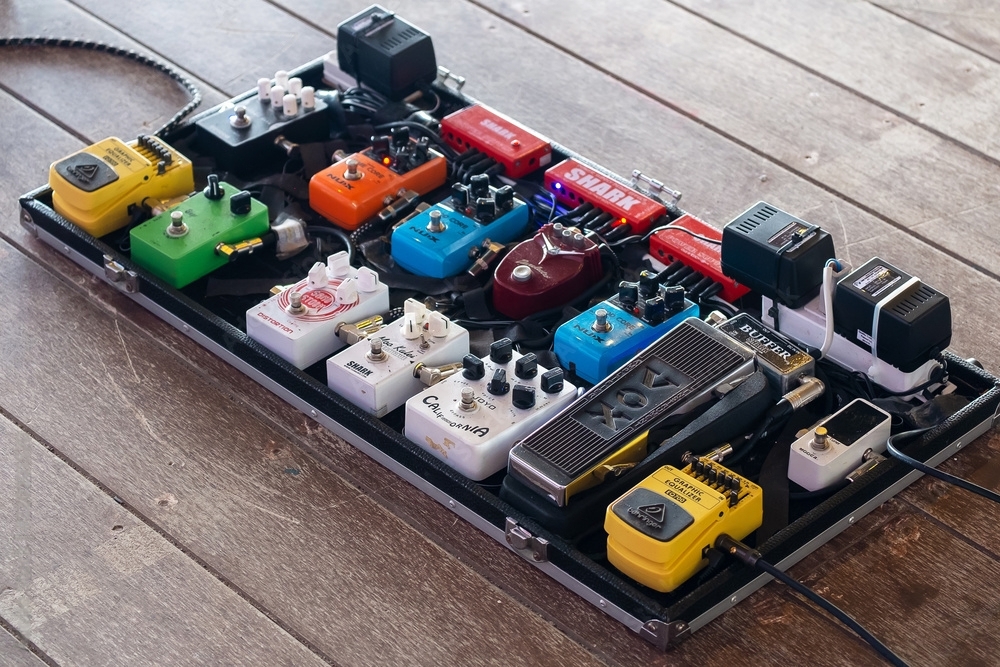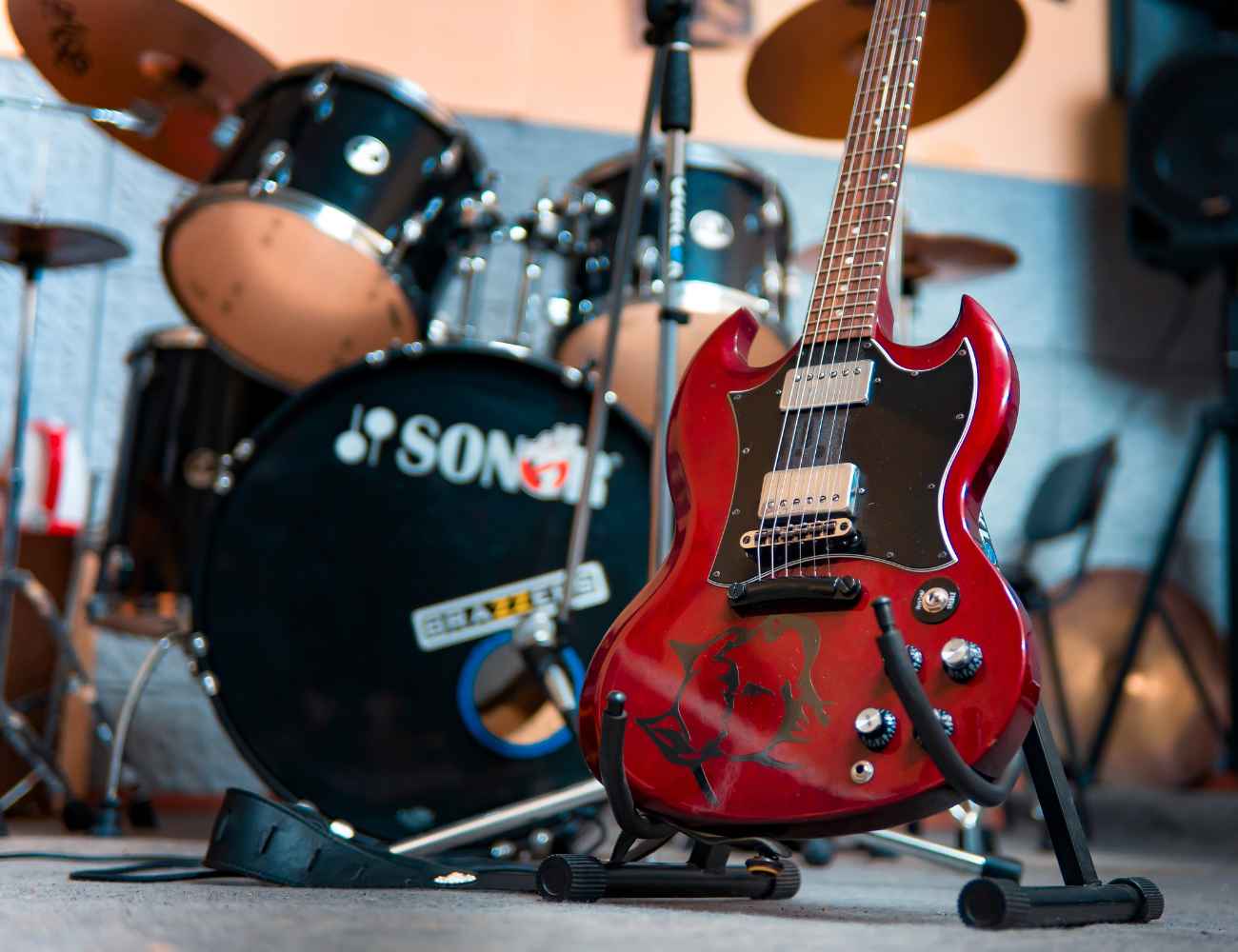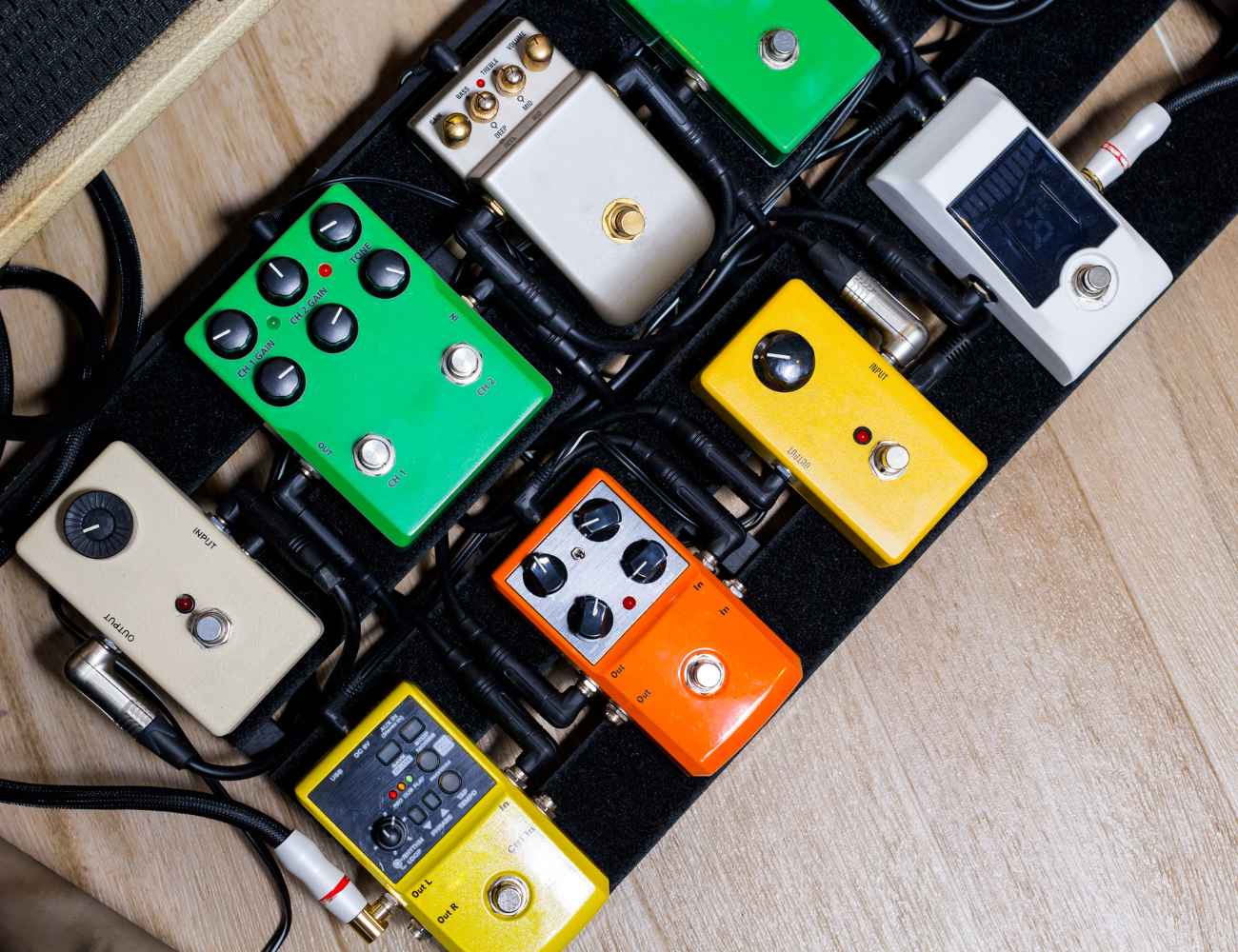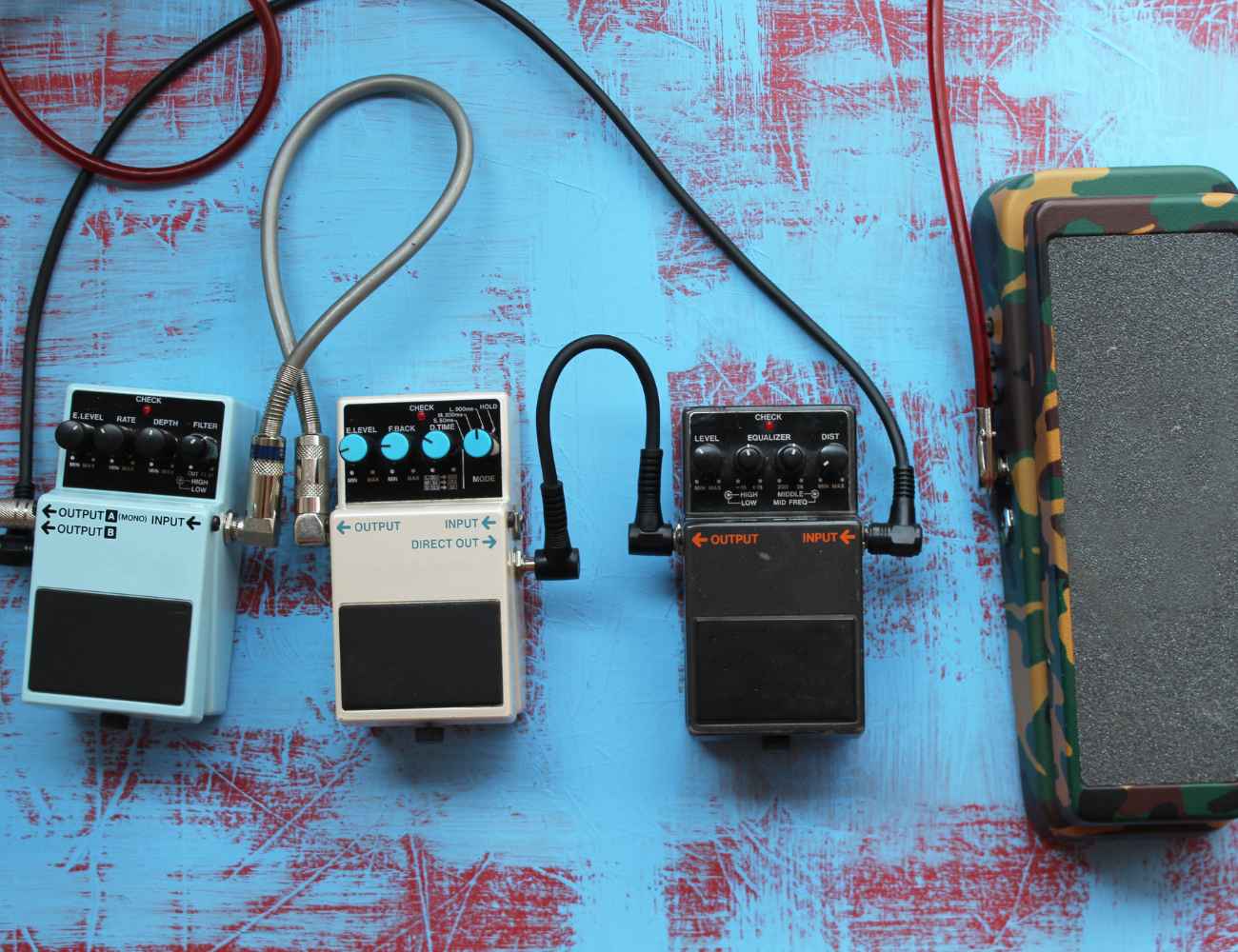Are you a budding guitarist wanting to dial up your sound but are held back by the weight of your wallet?
Well, you’ve hit the jackpot by landing here.
This article focuses on the best cheap guitar pedals, a little-known secret that can transform your music without breaking the bank.
We all know how important guitar pedals are in shaping the tone, adding versatility, and expressing individuality.
But does a heavy price tag always equate to quality? We’re diving headfirst into that question today.
You’ll discover my top picks, reviews, and insider tips to help you make an informed decision.
So keep reading to amp up your guitar game, all while saving some precious cash.
Table of Contents
- Best Cheap Guitar Pedals
- NUX Horseman Overdrive Guitar Effect Pedal
- Jim Dunlop Distortion Guitar Pedal
- TC Electronic ECHOBRAIN Vintage-Style Delay Pedal
- MOOER Acoustic Guitar Effect Pedal
- TC Electronic JUNE-60 Legendary Stereo Chorus Pedal
- NUX Steel Singer Drive pedal
- Electro-Harmonix Nano Clone Chorus Pedal
- Ibanez Tube Screamer Mini Guitar Pedal
- Behringer VD400 Vintage Delay Guitar Pedal
- Pro Co RAT2 Distortion Pedal
- Behringer SF300 Super Fuzz Guitar Pedal
- NUX Tape Core Deluxe Pedal
- Boss DS-1 Distortion Pedal
- TC Electronic SKYSURFER Reverb Pedal
- Mooer Black Secret Distortion Micro Pedal
- Why should you consider cheap pedals?
- How do you know if a cheap pedal is of good quality?
- Are there any downsides to using cheap pedals?
- How to order pedals on a pedalboard?
- Boutique vs. Mass-Produced pedals
- How much should you spend on a guitar pedal?
- Can you use a guitar pedal with a bass guitar?
- How to properly power your pedals?
Best Cheap Guitar Pedals
Before I begin, here are my top selected choices:
Jim Dunlop Distortion Guitar Pedal

Authentic 70s and 80s sound with Jim Dunlop’s Distortion+ pedal. Check Price
|
|
Behringer VD400 Vintage Delay Guitar Pedal

Authentic analog delay with 300ms of vintage tone. Check Price
|
NUX Horseman Overdrive Guitar Effect Pedal
NUX Horseman Overdrive Pedal with Gold/Silver Modes and True/Buffer Bypass.
This pedal is loaded with classic overdrive tones, ranging from light to heavy, and features a unique design for a truly unique sound. It also has two output jacks for stereo operation, plus a blend knob for blending both overdrive effects together.
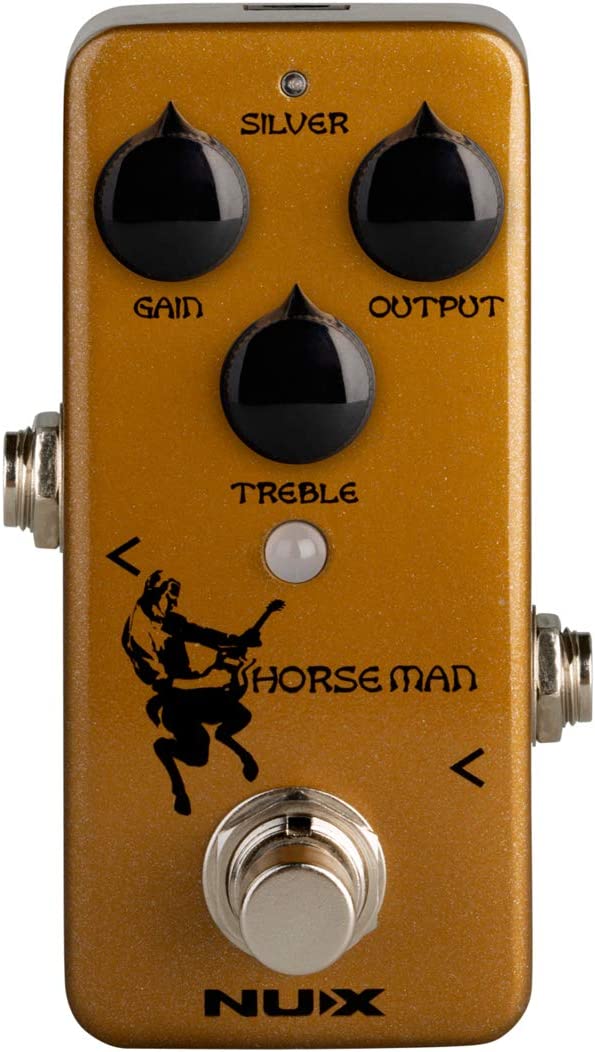
The NUX Horseman Overdrive Guitar Effect Pedal is quite an intriguing piece of gear.
Its design takes inspiration from the legendary Klon Centaur Pedal, mimicking not one but two of Centaur’s iconic overdrive modes – Gold and Silver.
With this, it caters to many tonal preferences, making it a versatile addition to any musician’s setup.
A notable feature of this gadget is its compact footprint, yet don’t let its size deceive you; it’s fully loaded with potent sound-shaping capabilities.
NUX Horseman is built to have a buffered bypass, which guarantees the integrity of your guitar’s tone, preserving the natural timbre even with longer cable runs.
It’s like a secret weapon, delivering high-quality overdrive tones with just a few simple controls: Gain, Treble, and Output.
Highly efficient, this pedal presents an excellent tool for sculpting your unique sound.
Its practical simplicity and tonal diversity make the NUX Horseman a worthy addition to any pedalboard.
- My Review
Having a firsthand experience with the NUX Horseman Overdrive Pedal, I can confidently say that this piece of equipment doesn’t just talk the talk but also walks the walk.
Compact in size, it’s quite the surprise in a small package.
However, despite its humble size, its performance isn’t short of extraordinary.
Lovingly replicating the revered sounds of the Klon Centaur, it doesn’t just ride on the coattails of its inspiration; it carves out its own identity.
Switching between Gold and Silver modes, I could dial in a wide spectrum of overdrive tones – a richness of options that adds considerable charm to this pedal.
But let’s talk about how it interacts with the guitar’s natural timbre.
Plugging in, I noticed that my guitar’s essence was preserved, not dampened or colored in any wrong way.
This buffer bypass feature proved to be not just a spec on paper but a reality that I felt in each chord, each strum.
However, it’s not all sunshine and rainbows. The NUX Horseman has its quirks.
For instance, the Treble control took some getting used to.
It wasn’t quite as intuitive as I’d expected, but I found a sweet spot after some experimentation.
Similarly, while the compact size is a boon regarding space on the pedalboard, some might find the small knobs fiddly.
All said and done, the NUX Horseman Overdrive Pedal is a commendable contender in overdrive effects.
It’s akin to a Swiss army knife in its versatility while respecting the distinct flavor of your guitar’s sound.
Here are the ratings I’ll give to the NUX Horseman Overdrive Guitar Effect Pedal:
Not without its quirks, it nonetheless proves itself a worthy companion on your musical journey.
When fully understood and harnessed, its features can be the hidden ace up your sleeve, shaping your sound in compelling and gratifying ways.
- Pros:
- Great tone
- Two modes for versatility
- Good value for the money
- Compact size
- Cons:
- Quality control issues reported
- Reliability concerns for some users
- Noise issues (crackling, popping)
My final verdict is that the NUX Horseman Overdrive Guitar Effect Pedal offers great tone and versatility with its two modes, providing users with options for different styles and gain levels.
In addition, the pedal’s compact size and affordable price make it an attractive choice for guitarists seeking a Klon-style overdrive without breaking the bank.
However, there are some concerns regarding quality control, reliability, and potential noise issues reported by certain users.
The NUX Horseman pedal can be a worthwhile addition to a guitarist’s effects arsenal considering its positive aspects and value.
Still, caution should be exercised due to the mentioned drawbacks.
Jim Dunlop Distortion Guitar Pedal
Authentic 70s and 80s sound with Jim Dunlop’s Distortion+ pedal.
MXR is a renowned manufacturer of effects pedal, offering classic and modern sounds with true bypass switching and wide range of controls. The high-quality pedals are used by many of the world’s top musicians, providing great sound to any guitar rig.
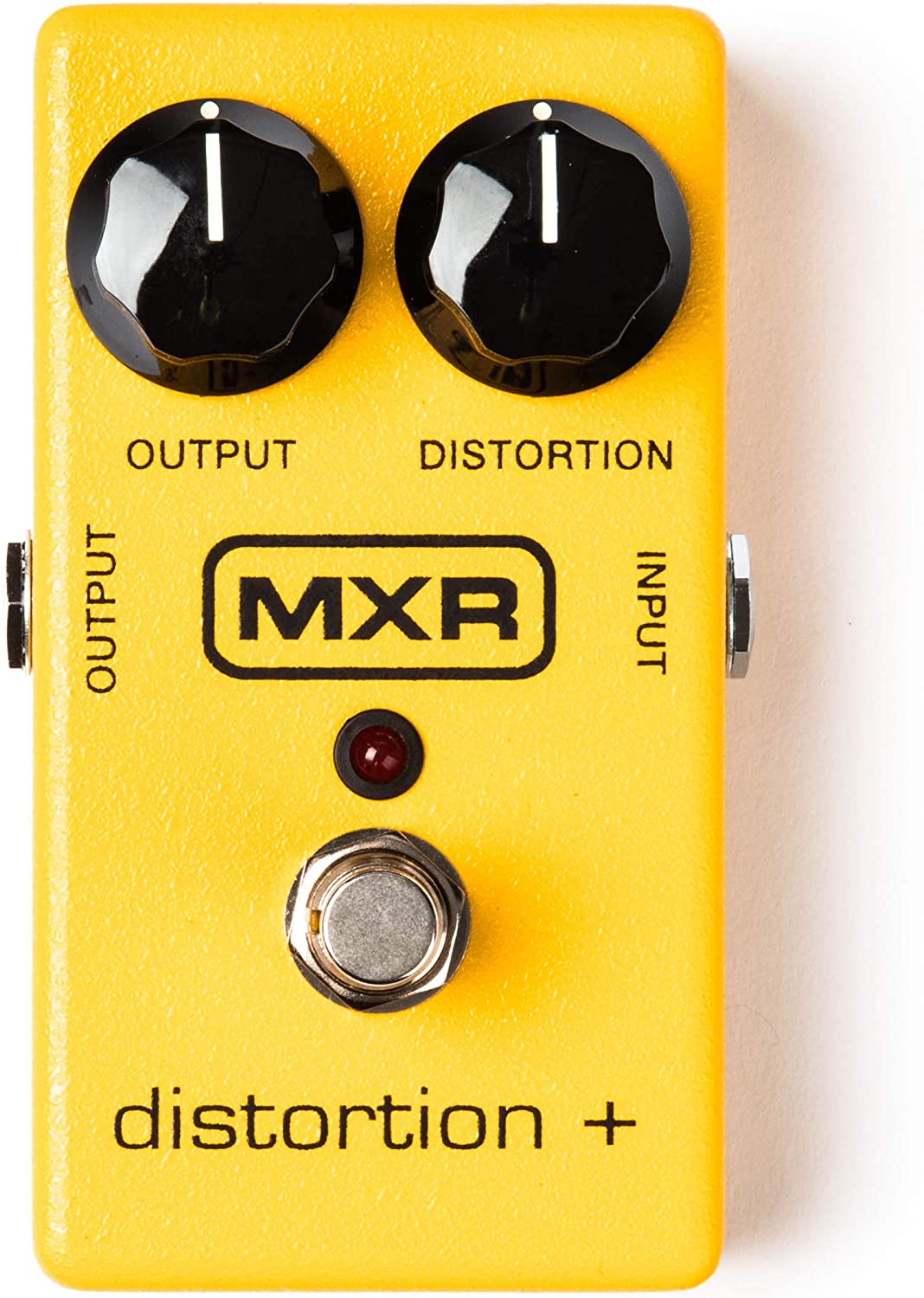
Meet the Jim Dunlop Distortion +, a pedal crafted to deliver that classic 70s and early 80s hard rock tone you’ve been craving.
With its germanium-powered, soft-clipped distortion, this little stompbox might be the missing piece to your sound.
Identified as Model Number M104, this unit packs a punch while still retaining a certain delicacy to its tone.
This multicolored pedal, courtesy of the renowned brand JIM DUNLOP, showcases a knack for combining style and substance with features such as Distortion, Overdrive, and Reverb.
Don’t be fooled by its compact size; measuring 5.5 x 2.5 x 4.5 inches and weighing in at 1 pound, it’s designed to be an easy addition to your pedalboard without sacrificing functionality.
But there’s more to this pedal than meets the eye.
It’s a product of MXR, a New York-based company renowned for its high-quality effects units.
Now under the umbrella of Jim Dunlop, MXR continues its legacy of innovation and stellar design.
- My Review
Diving into the Jim Dunlop Distortion +, I was transported back to the heyday of rock with its unmistakable, germanium-powered tone.
With its subtle blend of distortion, overdrive, and reverb, this pedal gave me that sought-after vintage vibe.
Crunching into its sound, I experienced a sense of delight and nostalgia.
It wasn’t just distortion—that raw, gritty 70s tone fused with the punchy early 80s hard rock sound, a perfect combo of decades’ worth of iconic music.
Dialing in was a breeze, too.
With just two knobs for output and distortion, I captured a wide range of tones, from a slight breakup to a rich, thick gain.
However, it’s worth noting that this isn’t a pedal for the metalheads seeking a heavy saturation.
Instead, it shines in its realm, namely, classic rock and perhaps a bit of blues.
Its tonal characteristic leans toward a warm, vintage territory rather than a high-gain beast.
As for the build quality, it’s like a tank—durable and ready for road use.
Its design is streamlined, compact, and notably lightweight, making it a practical addition to any pedalboard.
Although the bright exterior might seem unconventional, it does lend a unique charm to the stompbox.
One aspect that did catch my attention was the “output” knob.
The function of this knob didn’t seem as intuitive as expected.
Even at 50%, I found that the pedal still boosted the output significantly.
Here are the ratings I’ll give to the Jim Dunlop Distortion Guitar Pedal:
Despite a couple of quirks, the Jim Dunlop Distortion + pedal can open up a new world of vintage tones for your setup.
It’s like a sweet piece of nostalgia ready to be stomped on, eager to deliver those classic tones that shaped the rock music we all love.
- Pros:
- Versatile and classic distortion tones
- Germanium-powered for a soft-clipped distortion
- Durable construction and tank-like build quality
- Good for achieving Randy Rhoads-style distortion
- Can be used as a booster for lead work
- Cons:
- May not cover a wide range of sounds
- Some users experienced hiss and interference
- Doesn’t replicate vintage versions for some users
My final verdict is that the Jim Dunlop Distortion + is a highly recommended distortion pedal for guitarists seeking versatile and classic tones.
Its Germanium-powered soft-clipped distortion delivers excellent sustain and harmonics, making it ideal for lead players.
In addition, the pedal’s durable construction, compact size, and simple operation add to its appeal.
While it may not cover a wide range of sounds, and some users reported issues with hiss and interference, it offers great performance and value overall.
With a strong brand reputation and positive user reviews, the Jim Dunlop Distortion + earns a solid recommendation.
TC Electronic ECHOBRAIN Vintage-Style Delay Pedal
Authentic vintage delay sounds in an affordable, compact package.
ECHOBRAIN ANALOG DELAY is an all-analog, bucket-brigade delay pedal with a classic design delivering up to 300ms of delay time and self-oscillation for vintage-style echoes and runaway delays. It has a metal chassis and dedicated Input, Output, and True Bypass for a roadworthy and pedalboard-friendly experience.
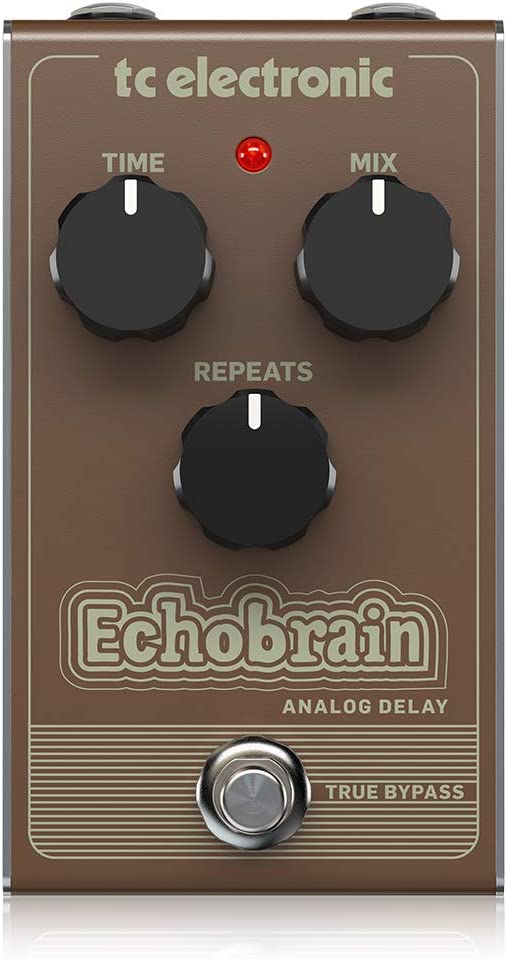
The product we’re looking at is the TC Electronic ECHOBRAIN ANALOG DELAY.
It’s a vintage-style delay pedal that boasts an all-analog bucket-brigade circuit.
This design brings forth a variety of classic delay tones, echoing the sounds of yesteryears in a new and exciting way.
In addition, this compact stompbox is housed in a durable metal chassis, making it roadworthy and pedalboard friendly.
Among its key features, we find the true bypass function, ensuring the integrity of your signal even when the pedal is disengaged.
Controlling the ECHOBRAIN is easy with its intuitive three-knob layout, which allows you to manipulate time, mix, and repeat to create your desired echo effect.
It’s also versatile in terms of power supply, as it can run on a 9V battery or via a TC Electronic Power plug 9, none of which are included in the purchase.
With a weight of 0.45 kilograms and dimensions of 5.2 x 2.28 x 2.91 inches, it offers an appealing balance between performance and portability.
- My Review
From the get-go, I appreciated the ECHOBRAIN ANALOG DELAY for its compact and sturdy design.
Crafted in a resilient metal chassis, it withstands the rigors of gigging and travel and sits comfortably on a crowded pedalboard.
Turning the knobs and dialing in settings was a delight – the controls are streamlined, making navigating through the desired delay effects simple.
Time, mix, and repeats were at my fingertips, creating a playground of sonic possibilities.
Not to forget the ease of power options – a quick pop-in of a 9V battery or plugging in a TC Electronic Power plug 9, you’re all set for the session.
Of course, the real charm of this pedal lies in its sound.
With its bucket-brigade circuitry, the ECHOBRAIN fires up a kaleidoscope of warm, vintage echoes.
On one end, tight, rhythmic slapbacks punctuated my riffs, while at the other, I was basking in vast, lush repeats, akin to a warm blanket of sound engulfing my music.
That being said, the ECHOBRAIN has its idiosyncrasies.
While it offers up to 300 ms of delay, don’t expect to paint in broad strokes of epic, stretched-out soundscapes.
Instead, it leans towards shorter delay times, imbuing your sound with a characteristic charm.
It’s like a spicy garnish that adds zest to your music rather than being the main course.
The true bypass is invaluable, ensuring that the pedal does not color your signal when disengaged.
However, I noticed a slight tonal change when I switched off the pedal, which may not be everyone’s cup of tea.
Ultimately, the ECHOBRAIN ANALOG DELAY from TC Electronic is a charismatic vintage-style delay pedal.
Here are the ratings I’ll give to the TC Electronic ECHOBRAIN Vintage-Style Delay Pedal:
It delivers a great performance and could be useful for those seeking a blend of warm, vintage tones and modern convenience.
It’s a charming, old-school echo box tucked in a stylish package – like a vintage photo processed through a modern filter.
- Pros:
- Excellent delay signal with simple controls.
- Versatile for different echo sounds.
- Sturdy and compact design.
- Easy-to-use control layout.
- Great vintage tones.
- Cons:
- Volume level may vary depending on context.
- Switch activates on release, not press.
- Short delay time for certain styles.
- Size and weight may be an inconvenience.
- Limited mixing options.
My final verdict is that the TC Electronic ECHOBRAIN ANALOG DELAY is a highly recommended delay pedal for vintage effects enthusiasts.
Its all-analog bucket-brigade circuit delivers warm and organic echoes, from classic slap-back to lush ambient repeats.
The pedal offers simplicity and ease of use with its straightforward control layout.
It may not have all the advanced features of digital delays, but it excels in providing excellent vintage tones and inspiring creativity.
The TC Electronic brand is known for its quality components, and the pedal’s sturdy construction reflects that.
Considering its affordable price point, the ECHOBRAIN ANALOG DELAY offers great value.
However, it’s important to note that some users have experienced limitations in mixing options, short delay times for certain styles, and potential quality control issues.
Overall, if you’re seeking an affordable analog delay pedal with vintage character, the TC Electronic ECHOBRAIN ANALOG DELAY is worth considering.
MOOER Acoustic Guitar Effect Pedal
Smooth optical compression in a road-ready, space-saving design.
The Mooer Yellow Comp optical compressor pedal is a durable, road-ready effects pedal with classic optical compression, smooth attack and decay, and true bypass. It preserves original signal transients without coloring your sound.
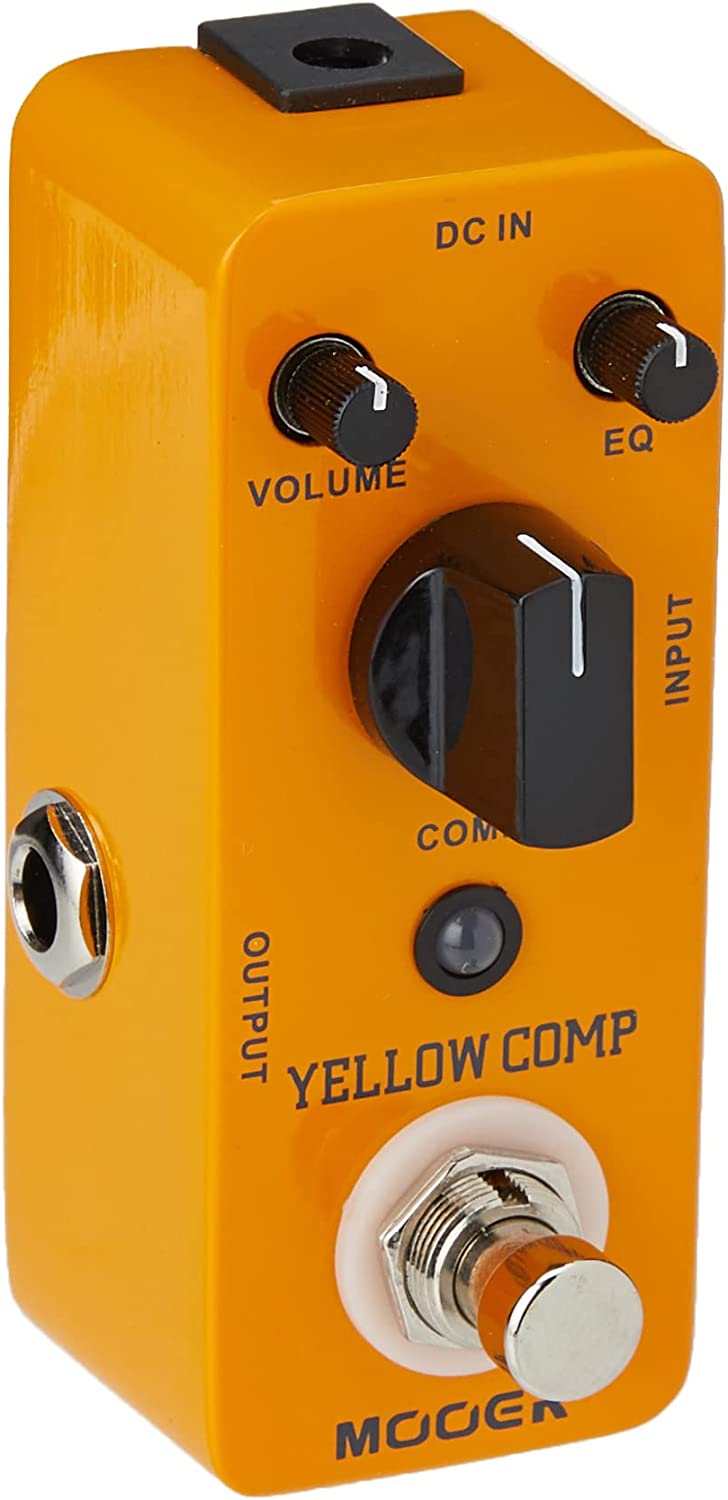
The MOOER Yellow Comp Acoustic Guitar Effect Pedal.
Standing at a compact 1.75 x 4.25 x 2.25 inches and weighing just 0.16 kilograms, this little marvel is ideal for those looking to maximize their pedal board space without compromising sound quality or functionality.
The pedal is encased in a durable, all-metal shell, making it road-ready and resilient to wear and tear.
At its heart, the Yellow Comp is an optical compressor known for delivering smooth compression while preserving the natural transient characteristics of your guitar’s tone.
This means you get a naturally smoothed output without the risk of marring the original sound.
Another standout feature is its EQ knob, which subtly but effectively alters the compression applied to low or high frequencies.
This essentially operates like a top cut and can help you tailor your tone the way you like it.
This particular pedal model also stands out as it doesn’t result in volume loss, a common issue with certain compressor pedals.
On the other hand, this MOOER pedal is designed to amplify the level of quieter notes, which is a boon for those seeking to achieve unity gain.
One thing to remember is that it requires a power supply due to its compact size.
- My Review
Upon unboxing the MOOER Yellow Comp Acoustic Guitar Effect Pedal, the first thing that strikes you is its compact size and robust metal casing.
Straight away, you sense that this small footprint won’t crowd your pedalboard, yet it’s sturdy enough to take on the rigors of gigging.
And this cool, bright yellow finish makes it stand out amidst a sea of pedals.
A swift dive into the intricacies of this pedal reveals that it’s an optical compressor, a real gem for those who value tone preservation.
The compressor adds a little shine to your guitar sound, smoothing out the rough edges while leaving the heart of your tone untouched.
The Yellow Comp’s EQ knob turned out to be a personal favorite of mine.
It offers an exquisite level of control, allowing the pedal to sing, whether you’re adding compression to those plucky highs or deep, resonant lows.
It’s like having a magic dial to fine-tune your sound, adding a touch of sparkle or a hint of warmth as you see fit.
An area of concern that often emerges with compressor pedals is unwanted volume loss.
Well, not in the case of the Yellow Comp.
It does a fantastic job at maintaining unity gain, elevating those quieter notes without turning the louder ones into a racket.
However, it’s worth mentioning the pedal does need an external power source.
Given its small size, an in-built power supply would have been a challenge, but it’s something to keep in mind, especially if you’re moving.
Having played around with the Yellow Comp, I can say it’s a solid addition to any guitarist’s arsenal.
Here are the ratings I’ll give to the MOOER Acoustic Guitar Effect Pedal:
It punches above its weight regarding functionality and durability, offering a superb balance between performance and portability.
Just remember to have that power supply at hand!
- Pros:
- Smooth and transparent optical compression.
- Preserves original signal transients.
- Durable and road-ready full metal shell.
- Compact size, great for pedal board space.
- Cons:
- May not compress enough for some users.
- Can add noise in certain setups.
- EQ knob is limited in sensitivity.
My final verdict is that the MOOER Acoustic Guitar Effect Pedal offers a solid choice for guitarists seeking smooth and transparent optical compression.
It excels in preserving the original signal transients and comes in a durable, compact design.
While it may not suit users looking for heavy compression or those sensitive to noise, it provides good value for its features and performance.
It is reliable for enhancing your acoustic guitar’s tone and dynamics.
TC Electronic JUNE-60 Legendary Stereo Chorus Pedal
Authentic ’80s chorus with 2-button selector and BBD circuitry.
JUNE-60 CHORUS faithfully recreates the classic chorus sound from the Juno-60 synthesizer, offering two button effect selector and BBD circuitry for a lush, warm sound. Plug in for a slow and rich chorus, or switch to a faster wobblier chorus for a thick, groovy tone. Enjoy stereo output for deep and sultry pulsating tones or go mono for a crisp true-bypass sound.
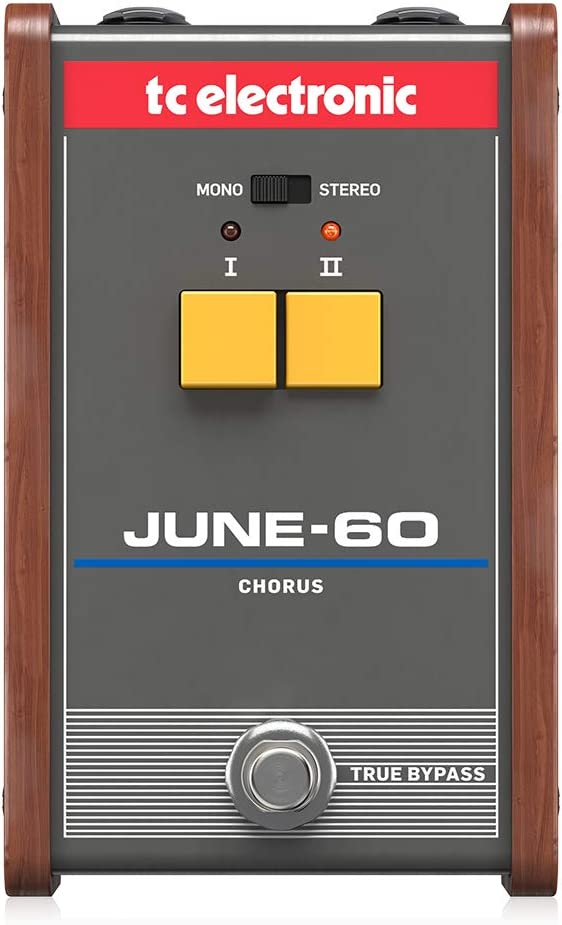
The TC Electronic JUNE-60 CHORUS is a pedal that revives the unmistakable chorus sound of the ’80s.
Designed to emulate the classic Juno-60 synthesizer, its two-button interface allows for simple, captivating modulation tone creation.
This pedal leverages authentic all-analog BBD (Bucket Brigade Delay) circuitry, contributing to its vintage sound.
Furthermore, it includes a mono/stereo switch, letting you choose between a direct and a more expansive chorus experience.
A unique feature of this pedal is its true bypass, which ensures the purity of your signal when the effect is off.
This compact pedal can effortlessly fit into any musician’s rig, measuring 5.39 x 3.39 x 2.2 inches and weighing 1.51 pounds.
Made to operate on 9 volts, it’s not just a piece of musical equipment but also a homage to a time when synthesizers ruled the music scene.
- My Review
Let’s stroll down memory lane with the TC Electronic JUNE-60 CHORUS.
This pedal is more than a simple box of wires; it’s like a time machine, carrying me back to the ’80s with its sonic signature.
Hitting those buttons, I could hear the echoes of the classic Juno-60 synthesizer resonating in my music.
Yet, it does so without any pretentious complexity, boasting a straightforward two-button interface that feels intuitive and user-friendly.
That being said, there’s a certain kind of magic in the authenticity of the all-analog BBD circuitry.
It gave me the sense of making music old-fashioned without sacrificing my control over the final output.
Switching between mono and stereo wasn’t just a technical decision; it felt like a creative choice, allowing me to fill the room with a warm wobble or keep things more direct and focused.
Now, let’s touch on some rough edges.
As I found out, there’s a little bit of a catch: the lack of easily accessible adjustments for the rate and depth of the chorus effect.
It was as if my hands were tied.
I had to resort to cracking open the pedal to tinker with some internal “pots,” which was quite a roadblock.
Another thing: the pedal’s design, with those wood-like panels, exudes a retro charm that I could not resist.
Its sturdy build gave me confidence that it could survive the rigors of a live gig or constant shuffling on my pedalboard.
Yet, I should warn you, it’s not a shape-shifter, morphing into any sound you can dream of.
Instead, its voice is distinct, filled with ’80s nostalgia.
Here are the ratings I’ll give to the TC Electronic JUNE-60 Legendary Stereo Chorus Pedal:
This pedal will serve you well if that’s the sound you crave.
However, if you prefer a chorus pedal with a broad palette and myriad controls, you might find the JUNE-60 a bit narrow in its scope.
- Pros:
- Authentic Juno-60 chorus sound reproduction.
- Simple and intuitive 2-button interface.
- All-analog BBD circuitry for classic tones.
- Switchable mono/stereo operation.
- Cons:
- No controls for rate and depth adjustment.
- Limited to three preset chorus sounds.
- Possible noise issues in pedal chain.
My final verdict is that the TC Electronic JUNE-60 CHORUS pedal recites the iconic Juno-60 chorus sound with its all-analog BBD circuitry.
While it may lack extensive controls, it provides a simple and intuitive interface for easy modulation.
The pedal delivers impressive tone and performance, backed by the reputable TC Electronic brand.
Considering its value for the price, it is recommended for those seeking classic ’80s chorus effects.
NUX Steel Singer Drive pedal
Smooth, sweet overdrive from boutique amp.
Steel Singer Drive is an all-analog overdrive pedal providing vintage-style tones with a three-band EQ and level knob. Its true bypass switch ensures your signal remains unaltered when the pedal is bypassed. Perfect for vintage-style tone shaping.
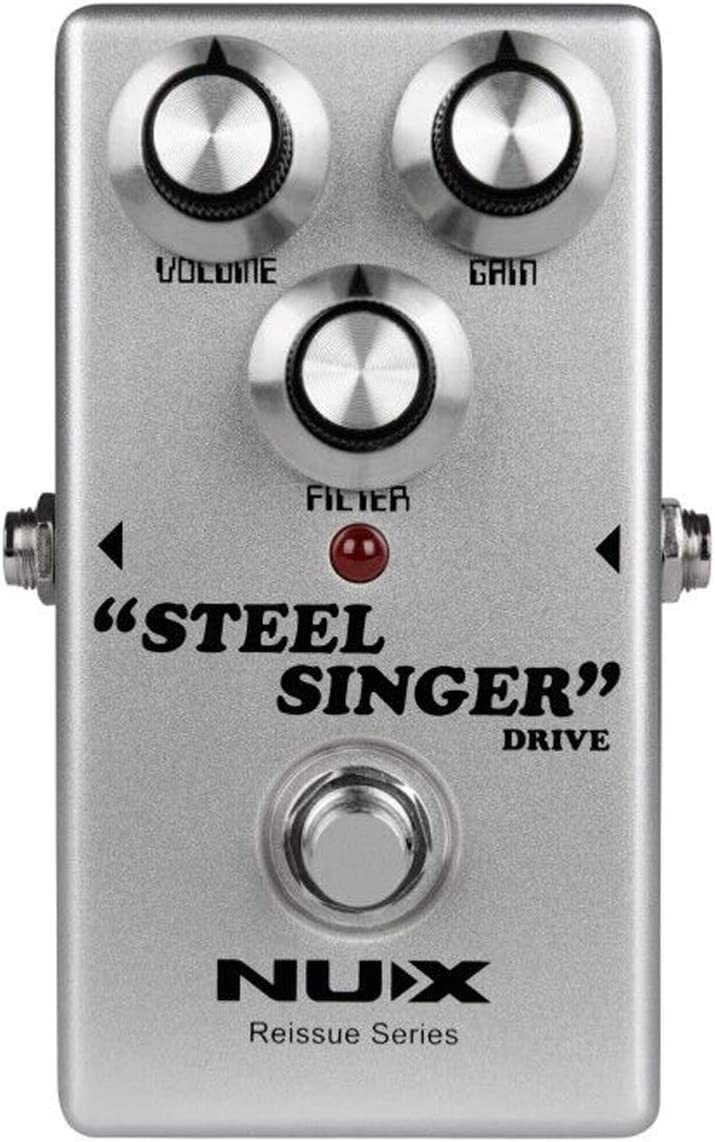
Imagine a unique overdrive pedal, the NUX Steel Singer Drive.
It belongs to the Reissue Series and mimics the distinctive tonal essence of a boutique amplifier originating from sunny California.
With its delightful balance of smooth high ends and sweet mid-range tones, this pedal provides a noteworthy sound experience.
Crafted by NUX, the unit is dressed in a sleek silver casing.
Despite its compact and lightweight design – just over 12 ounces -, it offers a robust and durable quality.
The pedal operates on a voltage of 9 volts, striking the perfect balance between power and sound.
Dubbed the “Steel Singer Drive,” this pedal is not just about overdrive.
Instead, it is a blend of style and functionality poised to reshape your perception of sound, offering a transformative audio experience in a small, sturdy package.
It’s a piece that proudly carries its brand’s stamp while setting its mark on overdrive pedals.
- My Review
There’s a certain mystique in strumming those strings with the NUX Steel Singer Drive pedal at my feet, creating this symphony of tones.
Unboxed, the first thing that struck me was the pedal’s sleek silver casing, the kind of design that screams durability.
A bit on the lighter side of the spectrum, but don’t be fooled.
It packs a punch, much like a featherweight boxing champion.
Plugged it in, and we were off to California, a state known for its sunshine and boutique amps.
The pedal’s overdrive character transports you to those sunny shores.
It’s a rich, expansive sound, mimicking the famed Californian boutique amp vibe.
The high-end notes cascaded smoothly, complemented by a sweet mid-range, like honey in audio form.
My fingers worked their magic, coaxing out a surprising variety of tones.
The pedal wasn’t all sunshine and rainbows, though.
Despite its homage to a particular amp style, it felt unique, grittier, and more assertive, like an old blues singer at a smoky bar.
Running on 9 volts, it packs quite a wallop. Crank it up, and it delivers a powerful performance.
But here’s the real kicker: even at lower settings, the pedal maintained a desirable character and tone.
So yes, it has an attitude.
A true “Steel Singer.”
Of course, it’s not without its quirks.
For one, the knobs on this device don’t exactly scream high quality, they are a bit shaky, perhaps.
Then there’s the matter of its character.
While it replicates the boutique amp style, it does so with its flair, which may or may not align with your taste.
So, would I recommend the NUX Steel Singer Drive pedal?
Here are the ratings I’ll give to the NUX Steel Singer Drive pedal:
In the grand symphony of tones and overdrive options, it is a unique instrument, both an homage to a beloved amp style and an assertion of its own identity.
It’s a journey to California, with some unexpected pit stops.
- Pros:
- Authentic amp-like overdrive
- Smooth high-end and sweet mid-range
- Reasonable price for the quality
- Different tone from the clone it emulates
- Solid steel casing and tight jacks
- Cons:
- Some reports of flimsy knobs
- Limited tone shaping options
- May not clean up well at lower volumes
- Not suitable for clean boost settings
- Not an exact clone of the intended amp
My final verdict is that the NUX Steel Singer Drive pedal offers an authentic amp-like overdrive with a smooth high-end and sweet mid-range.
It provides good value for the money and is suitable for blues and classic rock styles.
However, there are some reported issues with flimsy knobs, limited tone shaping options, and possible quality control and noise problems.
In addition, the pedal may not clean up well at lower volumes and may lack bottom-end and mid-range presence.
It can be a solid choice for those seeking a specific type of overdrive, but individual preferences may vary.
Electro-Harmonix Nano Clone Chorus Pedal
Compact, powerful chorus pedal with true bypass and LED indicator.
The Electro-Harmonix Nano Clone Chorus Effect Pedal offers a compact, battery-operated design with Rate and Depth knobs. The footswitch engages and disengages the Chorus effect, producing a doubling effect with the LED indicating when it is switched on.
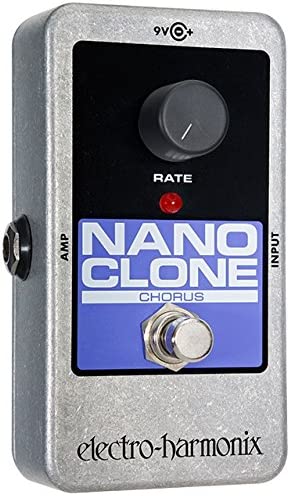
Hailing from the Electro-Harmonix family, this Nano Clone Chorus Pedal is a compact, die-cast device packed with features.
Its distinctive red body houses a true bypass function and a rate knob for easy adjustments to your sound.
Despite its compact size, measuring 5.75 by 2.75 by 3.45 inches, it can easily rival its larger counterparts in terms of functionality.
It’s fairly lightweight, too, tipping the scales at just 0.65 pounds.
Inside, it’s powered by a 9-volt battery, which comes included.
Alternatively, if you’re after a more consistent power source, you can use the 96DC-200BI power supply, available separately.
At the heart of its operation, the Nano Clone creates a chorus effect by subtly bending the input frequency and mixing this with the direct, unaffected signal.
This technique results in an intriguing doubling effect.
An integrated LED indicates when this effect is on, controlled via the easy-to-use footswitch.
- My Review
Let me tell you about my experience with the Electro-Harmonix Nano Clone Chorus Pedal.
This little device, with its bold red shell, carries a punch!
It’s small, which can mean a lot that can mean a lot in the world of effects pedals.
Space on a pedalboard is premium real estate, and this little guy is a tenant that’s worth the space.
Here’s what caught my attention.
First, it has a true bypass function, a boon for those who like their signal unaltered when the effect is disengaged.
This keeps your original sound intact, and that’s a winner in my book.
And its rate knob is as responsive as you’d like, taking you from a gentle flutter to a Leslie-like warble with ease.
However, it’s not always pleasant and trouble-free.
While it has a robust sound, some might find it too simplistic.
A depth knob wouldn’t have been amiss to dial back the effect or push it further for a lush sound.
That’s something I missed while putting the Nano Clone through its paces.
Now, power options are versatile. I like the fact that it can operate off a 9-volt battery.
Great for those gig situations where an extra power outlet is a luxury.
But I wished the 96DC-200BI power supply was included in the package.
Lastly, that LED indicator is a godsend, especially on darkened stages.
The footswitch felt a tad stiff at first, but maybe that’s just me needing to break it in.
This Nano Clone is a feisty little device that offers a good bang for the buck, despite a couple of minor drawbacks.
Here are the ratings I’ll give to the Electro-Harmonix Nano Clone Chorus Pedal:
It does its job, and it does it well.
For those who desire a straightforward, no-nonsense chorus pedal, it’s a solid choice.
- Pros:
- Compact and space-saving design.
- Affordable price point.
- Produces a pleasant chorus effect.
- Easy to use with simple rate knob.
- Can create different modulation effects.
- Cons:
- Some users experienced background hiss.
- Volume drop when the pedal is turned on.
- Not suitable for use with distortion.
- May require adjustments for optimal performance.
- Sensitive to power supply and daisy-chaining.
My final verdict is that the Electro-Harmonix Nano Clone Chorus Pedal is a solid choice for guitarists seeking an affordable and compact chorus effect.
While it may have some limitations and issues, such as background hiss and volume drop, it offers a pleasant chorus sound and good value for the price.
It is particularly suitable for clean tones and works well with reverb.
The pedal’s durability, brand reputation, and ability to create different modulation effects contribute to its overall appeal.
However, it is important to note that it may require adjustments and careful power supply considerations for optimal performance.
Ibanez Tube Screamer Mini Guitar Pedal
Iconic, versatile overdrive with classic green paint job.
The Ibanez Tube Screamer Mini is an iconic overdrive pedal with classic green paint job, three simple knobs, and powerful midrange growl. Its expressive touch sensitivity appeals to guitarists of all styles.
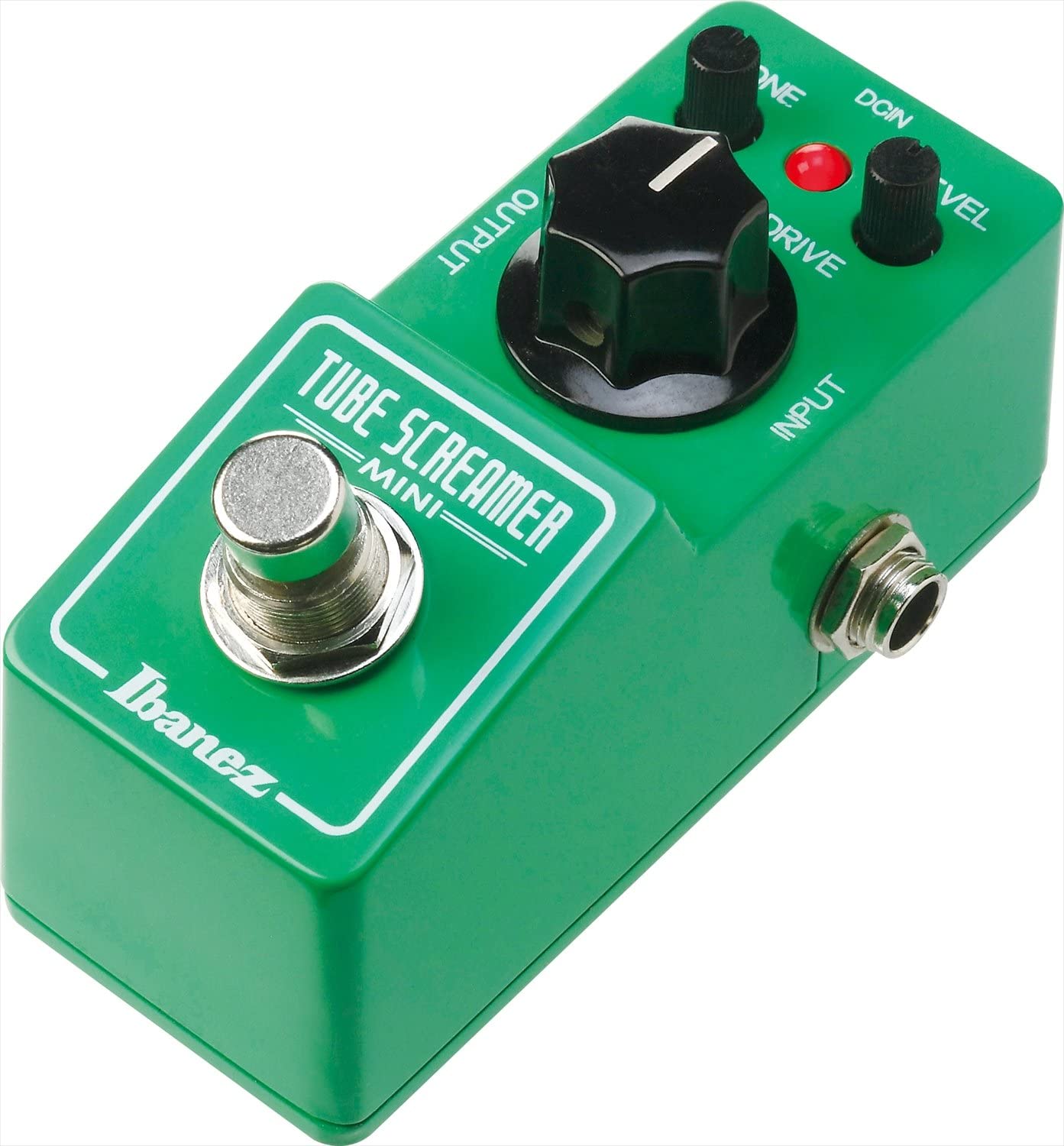
The Ibanez Tube Screamer Mini is a diminutive yet mighty addition to any guitarist’s pedalboard.
This compact beast, decked out in the Tube Screamer’s signature green, houses a world of tonal possibilities in its small casing.
Being an overdrive pedal, it’s known for delivering a captivating midrange growl that can elevate the sound of guitarists across diverse genres.
With three simple knobs – drive, tone, and level – you can mold an array of tones to match your musical needs.
Despite its mini moniker, the Tube Screamer Mini boasts dimensions of 5.98 by 2.99 by 4.02 inches and a weight of just 240 grams.
That makes it a space-efficient addition to your gear.
But don’t let its size fool you; it’s an Ibanez product through and through, which guarantees it’s reliable and well-crafted.
Remember, this is not just a miniaturized version of a classic – it’s a reimagining of a legendary tone machine, offering flexibility in a compact package.
- My Review
Tell me about my experience with the Ibanez Tube Screamer Mini, one of the most iconic overdrive pedals.
Right off the bat, it caught my attention with its easy-to-navigate compact design and recognizable green hue.
In addition, its slim shape is also perfect for when I find my pedalboard cramped with gear.
When it came to the sound, it didn’t disappoint.
With its distinctive midrange growl and noteworthy touch sensitivity, this little unit became an unexpected favorite among the various pedals I’ve tried.
However, I appreciate its versatility – you can customize your overdrive experience to suit any genre, from smooth jazz licks to crunchy rock riffs.
However, there’s no denying that the Tube Screamer Mini has flaws.
The placement of the tone and volume dials can often be less than ideal, making it almost like finding a needle in a haystack when trying to adjust settings.
What I found helpful was using a tiny trace of white paint on the indents, making them far more visible.
Here are the ratings I’ll give to the Ibanez Tube Screamer Mini Guitar Pedal:
One quirk I experienced with this pedal was the slight cut in the bottom-end sound I sometimes get when playing.
Sure, I wouldn’t call it a deal breaker, but for someone who trawled through countless products in search of that perfect overdrive, it might have been ideal not to have that subtle undertow.
- Pros:
- Compact size
- Authentic Tube Screamer tone
- Responsive stomp button
- Good for crowded pedalboards
- Cons:
- Possible switch-pop issue
- Some units may have defects
- Slight lack of bottom end
- Knob labeling is hard to read
My final verdict is that the Ibanez Tube Screamer Mini is a solid choice for guitarists looking for a compact overdrive pedal with the iconic Tube Screamer tone.
It offers good versatility and responsive performance and carries the trusted Ibanez brand.
While some units may have minor issues like switch-pop or lack of bottom end, overall, it provides great value for its size and sound quality.
It’s a worthwhile addition to any pedalboard, particularly for those seeking a classic overdrive sound in a smaller form factor.
Behringer VD400 Vintage Delay Guitar Pedal
Authentic analog delay with 300ms of vintage tone.
The VD400 Vintage Delay pedal offers up to 300 ms of true analog delay, plus a superb noise reduction circuit for classic 1960s studio sounds. Its Repeat Rate, Intensity, and Echo dials make it easy to create a wide range of delay effects.
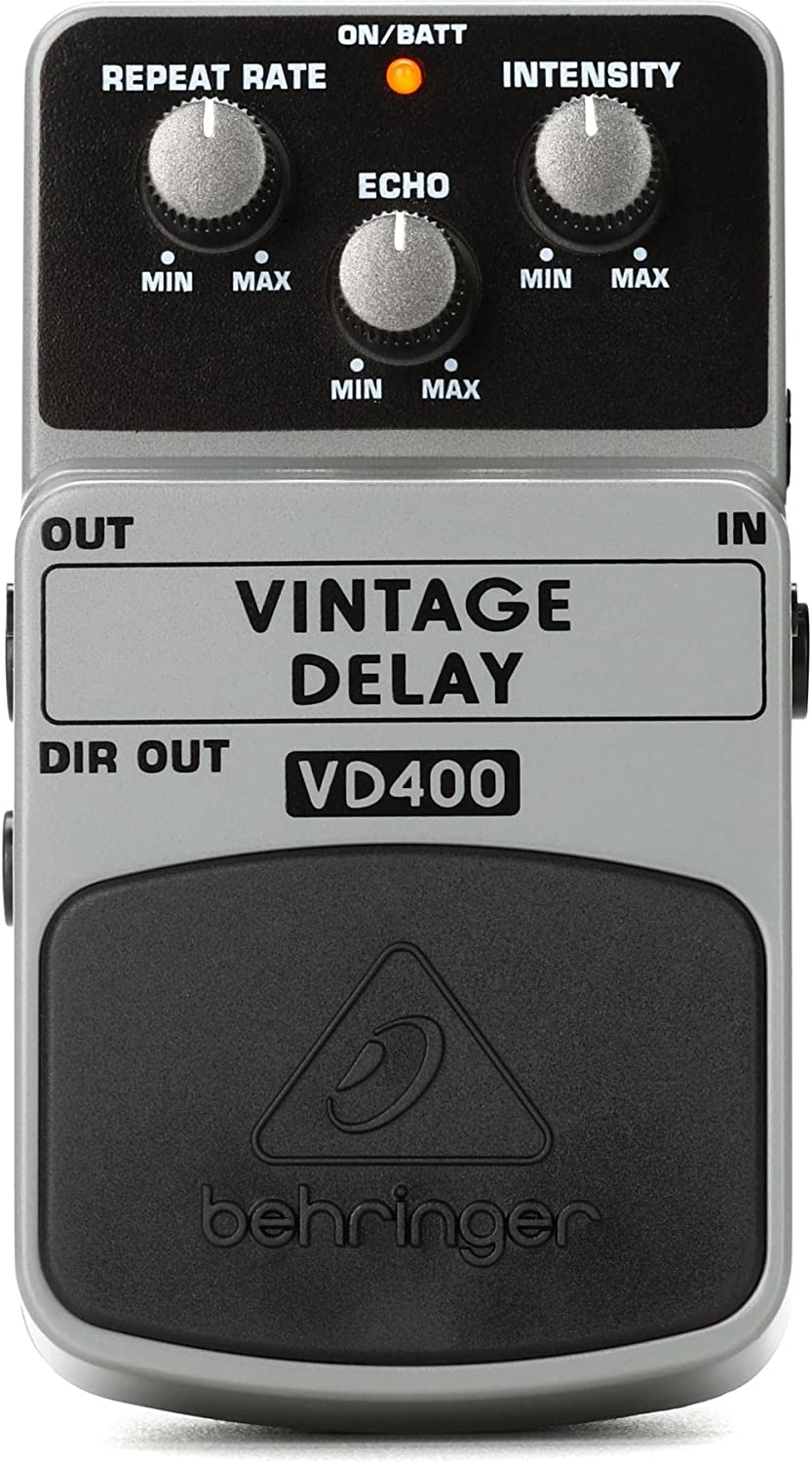
The Behringer Vintage Delay VD400 is an analog delay effects pedal designed to provide an authentic vintage sound for your guitar.
This pedal easily fits on your pedalboard with its white exterior and compact dimensions of 2.76 x 2.13 x 4.84 inches.
Weighing in at just 0.73 pounds, it is both lightweight and portable.
The VD400 features true analog delay and slap-back echo effects, which make it perfect for producing sounds reminiscent of classic 1960s recordings.
It utilizes vintage Bucket Brigade-style technology and offers up to 300 milliseconds of delay.
Thanks to its advanced noise reduction circuitry, your guitar signal will remain clean and free of unwanted noise.
The VD400 boasts dedicated controls for Intensity, Echo, and Repeat Rate for maximum versatility.
This allows you to shape your sound with precision and ease.
An amber status LED indicates when the effect is active and serves as a battery check.
The pedal can be powered by a 9V battery or the optional PSU-SB DC power supply (sold separately).
- My Review
I recently had the opportunity to experience the Behringer Vintage Delay VD400 analog delay effects pedal, which has left quite an impression on me.
The pedal is compact and lightweight, which makes it an excellent addition to my pedalboard, and its white exterior gives it a visually special touch.
As soon as I plugged in the VD400, I noticed it delivers an authentic taste of the bygone era of tape delays and vintage sounds reminiscent of the 1960s without losing any signal quality or clarity.
Taking advantage of the true analog BBDs and advanced noise reduction circuits, I was immersed in a world of rich, warm echoes and slap-back style effects.
While exploring the range of sounds I could create with the VD400, I appreciated how easy it was to shape and adjust the delay thanks to the dedicated Intensity, Echo, and Repeat Rate knobs.
From a smooth, barely-there echo to a surreal swirl of cascading recursions, I had no trouble finding the perfect level of subtlety or nuance for my playing.
That being said, the VD400 might not be everyone’s cup of tea—it is important to keep in mind that the maximum available delay of 300 milliseconds can be limiting if longer delay effects are desired.
Nonetheless, this limitation also fosters creativity by allowing me to explore sounds that otherwise would have been unattainable.
When powering the VD400, choosing between a 9V battery or the optionally included PSU-SB DC power supply adds versatility and convenience.
Finally, the top-notch battery check and bypass functionality make the performance seamless and worry-free.
Here are the ratings I’ll give to the Behringer VD400 Vintage Delay Guitar Pedal:
Ultimately, the Behringer Vintage Delay VD400, with its affordable price tag and authentic vintage sounds, is a valuable addition to my arsenal of effects.
Despite some limitations in delay length, it has captured the spirit of classic analog delay pedals and continues to inspire me as a guitarist.
- Pros:
- Authentic vintage analog delay sound.
- User-friendly controls for sound shaping.
- Affordable price and lightweight design.
- Cons:
- Limited to a 300-millisecond delay.
- Plastic construction may concern some.
- No included PSU-SB DC power supply.
My final verdict is that the Behringer Vintage Delay VD400 is a reliable analog delay pedal with an attractive price and a genuine vintage sound.
Its user-friendly controls and compact design make it a valuable addition to any pedalboard.
Despite some limitations, the VD400 provides excellent performance and tone quality, making it a worthwhile investment for any player looking for vintage delay effects.
Pro Co RAT2 Distortion Pedal
Legendary tones from pro artists with the Pro Co RAT2 Distortion Pedal.
The RAT 2 is a versatile distortion pedal for excellent arena rock rhythm tones and soaring leads. It also works as a boost for solos, providing extra kick. With its powerful amp and headroom, this pedal is perfect for any musician looking to get that sweet spot of warm overdrive.
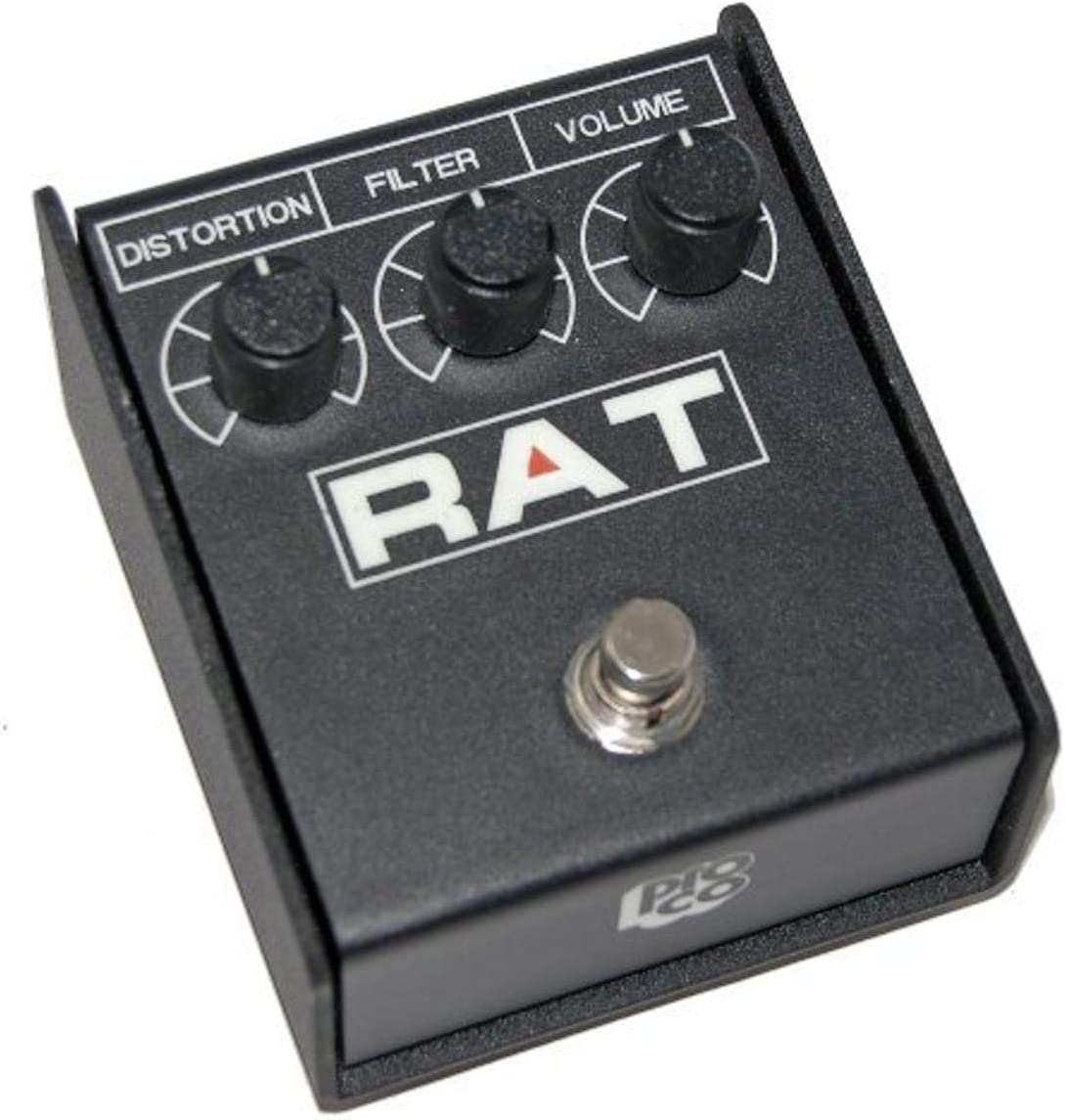
The Pro Co RAT2 Distortion Pedal serves as an excellent addition to any guitarist’s collection thanks to its impressive ability to switch between various distortion styles.
So whether you want to achieve that perfect, rocking arena rhythm tone or explore the rich, warm, overdrive territory, this pedal has you covered.
It can also function as an essential booster for powerful and expressive solos.
Manufactured by Proco and coming in a sleek black finish, the RAT2 measures 4.8 x 4.5 x 3.3 inches and weighs just 1 pound.
This compact pedal finds a firm footing for those craving that sweet spot where tube amps transition from clean to overdriven tones.
It prides itself on offering the perfect crunch for grunge enthusiasts while remaining rugged enough to endure the most intense stage performances.
Packed with varied and responsive features, the RAT2 Distortion Pedal is designed for dynamic guitar players looking for endless tonal options with their effects setup.
With this powerhouse, you’ll have a distinct sound seamlessly blending with the rest of your rig.
- My Review
Having experimented with the Pro Co RAT2 Distortion Pedal, I can confidently say it deserves a place on any serious guitarist’s pedalboard.
Its versatile nature helped me unlock a world of tonal variations – ranging from amazing rhythmic arena rock sounds to warm, saturated overdrive tones perfect for leads.
At first glance, I appreciated its compact size that, measured 4.8 x 4.5 x 3.3 inches, and at just 1 pound, it’s a great fit for players who desire an easy addition to their gig setup.
The sleek black finish also gives it an attractive appearance, evoking a sense of rock ‘n’ roll attitude.
After diving into its controls, the innate flexibility of the RAT2 became evident!
I easily explored its range of tones, dialing in warm bluesy sounds just as easily as creating wall-of-sound fuzz or aggressive distortion tones.
Perfect for getting deep into grunge territory or soaring through guitar solos with definition and sustain.
There’s something about this pedal that gives your guitar’s voice the extra punch it needs.
Using it as a boost for solos brings out that sharp, piercing edge without losing any sense of clarity or brilliance.
While it’s sturdy and durable, I noticed a few shortcomings here and there, including the potential for losing volume or low-end tone when engaged.
However, these downsides are relatively minor when considering the substantial gain offered by this humble pedal.
So, suppose you’re want to diversify your sonic landscape.
The Pro Co RAT2 Distortion Pedal is an outstanding choice to achieve that satisfying crunch or expressive boost with just enough finesse.
This powerful, versatile pedal is a hidden gem ready to unveil your inner rock star.
Here are the ratings I’ll give to the Pro Co RAT2 Distortion Pedal:
Pro Co Rat2 has undoubtedly proved to be an inspiring addition to my arsenal.
It’s worth giving it a try!
- Pros:
- Versatile distortion and overdrive tones.
- Durable and solid build quality.
- Transparent amp-like sound.
- Cons:
- Some units reported to have quality issues.
- Possible volume and low-end loss.
- Odd footprint on pedal board.
My final verdict is that the Pro Co RAT2 Distortion Pedal offers versatile tones, solid build quality, and great value for guitarists seeking a reliable distortion option.
With its impressive tone, performance, and reputable brand, this pedal is a solid investment for any avid musician.
However, some may experience potential volume, low-end loss, and occasional quality control issues.
Overall, it’s a worthy consideration for those searching for a versatile and transparent distortion pedal.
Behringer SF300 Super Fuzz Guitar Pedal
Three modes of operation for classic fuzz, grunge and gain boost.
The SUPER FUZZ SF300 provides three distinct fuzz distortion modes with dedicated Gain, Level, and 2-band EQ controls. It runs on 9V battery or BEHRINGER PSU-SB DC power supply and features an electronic On/Off switch for highest signal integrity in bypass mode.
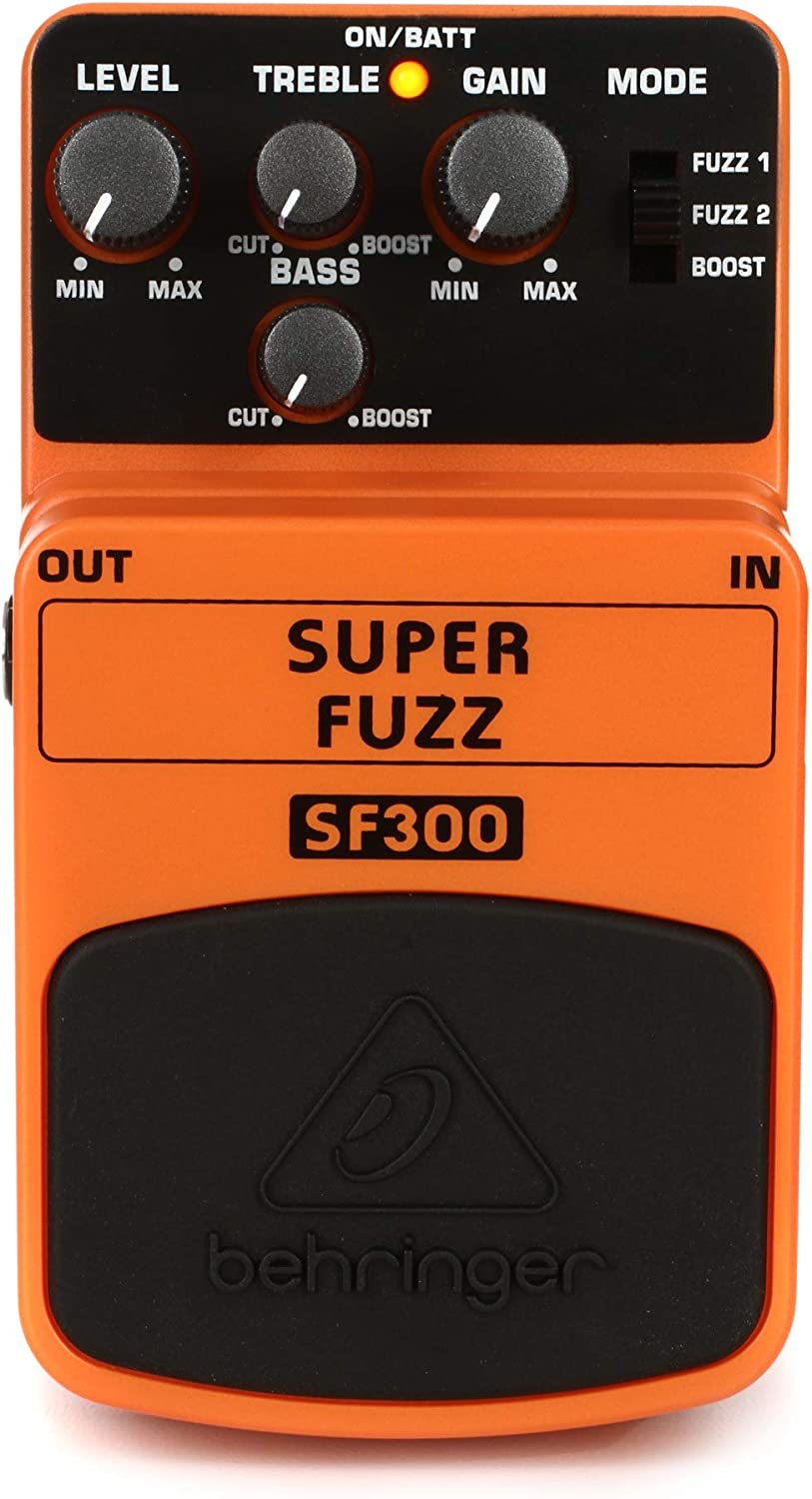
Behringer’s Super Fuzz SF300 is designed as an instrument effects pedal to emulate classic fuzz sounds from the 1960s and 70s.
Featuring three distinct modes, it allows you to choose from various fuzz tones, including classic fuzz, grunge, and gain boost.
Inside the peach-colored casing, you’ll find dedicated Gain, 2-band EQ, and Level controls for tailoring the perfect sound.
In addition, the pedal boasts a status LED indicating whether the effect is active and a battery check function.
It can run on a 9 V battery or the Behringer PSU-SB DC power supply, which is sold separately.
Offering an easy-to-use interface, the Super Fuzz SF300 is not only about vintage sounds but also boasts a convenient, first-class electronic On/Off switch, ensuring signal integrity in bypass mode.
In addition, it’s fitted with top-notch components and enclosed in durable construction, making it an affordable and suitable option for beginners or those looking to experiment with fuzz effects.
- My Review
Having tried the Behringer Super Fuzz SF300 effects pedal, I quickly discovered its key selling point: versatility.
With three distinct modes covering classic fuzz, grunge, and gain boost, the pedal convincingly recreates the vintage fuzz tones of the ’60s and ’70s.
In addition, these modes cater to various playing styles and sounds, making this pedal an attractive choice for musicians eager to experiment without breaking the bank.
One aspect I found particularly useful was the pedal’s dedicated Gain, 2-band EQ, and Level controls, which offer convenient sound shaping options.
Figuring out my preferred settings required a bit of tweaking.
Still, as soon as I nailed the right configuration, I was rewarded with a pleasingly warm and expressive fuzz that inspired creativity.
On the flip side, I must admit that the build quality presented a few concerns.
Though it’s housed in a rugged-looking peach case and comes equipped with high-quality components, the Super Fuzz SF300 feels a tad flimsy, with some knobs coming across as fragile.
You can’t expect the sturdiest materials at this price point, but I’ve seen stronger manufacturing from other pedals within the same range.
Another gripe I found was that certain tones could lean towards the buzzy and the less musical side, which might not appeal to every player.
Finally, although it does emulate vintage fuzz sounds quite well, it’s essential to keep expectations realistic – remember, this is not a high-tier, boutique-caliber device.
Here are the ratings I’ll give to the Behringer SF300 Super Fuzz Guitar Pedal:
The Behringer Super Fuzz SF300 is a feature-packed fuzz pedal that offers impressive versatility and customization at an affordable price point.
Despite certain shortcomings with build quality and tone, the pedal remains an enjoyable and well-built gadget, especially for beginners or those on a restricted budget.
- Pros:
- 3 different sound modes available.
- Affordable price for fuzz pedal.
- Great for 70s and 80s fuzz sounds.
- Cons:
- Some report poor build quality.
- Can sound buzzy and less musical.
- Manufacturer’s customer service issues.
My final verdict is that the Behringer Super Fuzz SF300 is a budget-friendly option for those looking to add a fuzz pedal to their setup.
It offers decent versatility and features but may fall short on tone and build quality for some users.
It’s a suitable choice for beginners or those seeking a specific sound on a budget, but those seeking higher quality may need to consider other options.
NUX Tape Core Deluxe Pedal
NUX Tape Core Deluxe: classic tape echo tones, 7 delay modes, USB upgradable.
NUX Tape Core Deluxe is a compact effects pedal with classic tape echo tones, 32-bit DSP, USB interface, and 3 repro heads for 7 different delay sound combinations. It also features Hi-Performance 24-bit 44.1kHz AD/DA Converter, tap switch delay time up to 1500ms, and stereo input/output jacks.
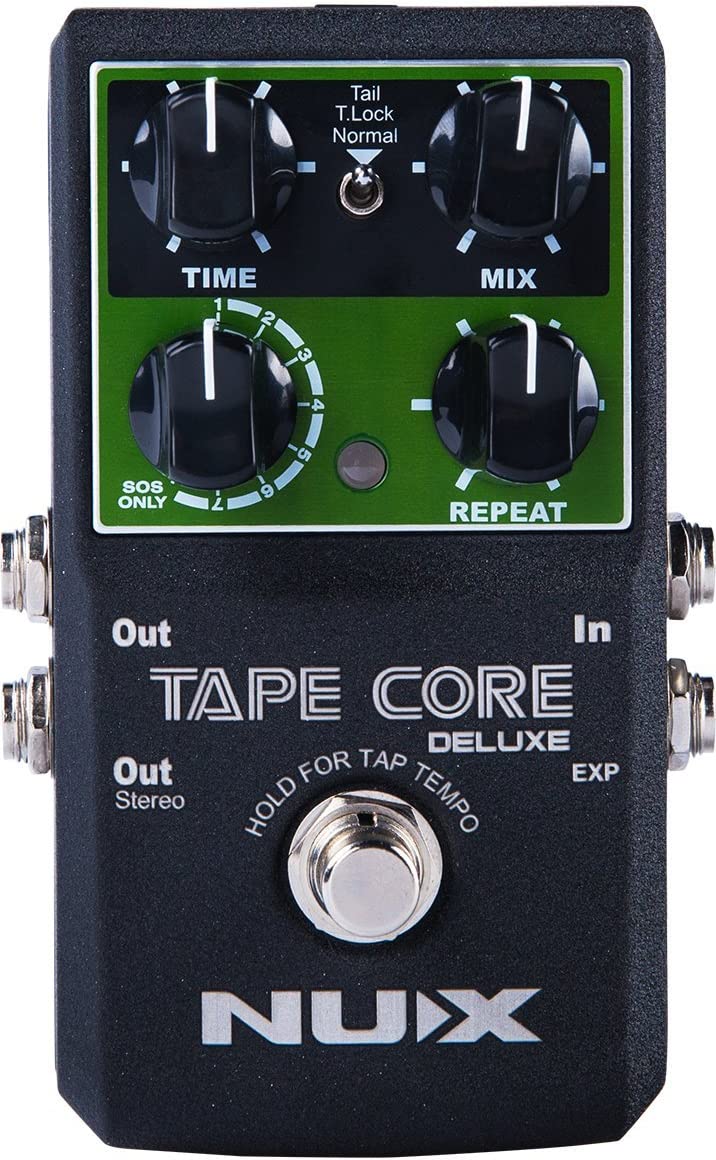
Let me tell you about the NUX Tape Core Deluxe Guitar Effects Pedal.
This compact stompbox takes inspiration from classic analog tape machines and effectively replicates their iconic echo.
With seven modes that blend three virtual tape heads, this pedal enables a wide range of rhythmic options.
It also features an 8th mode, Sound on Sound, for added functionality.
One of its standout features includes a tap-tempo mode, easily accessible by holding down the footswitch.
Moreover, the pedal allows you to save one preset and decide whether you want trails.
The product dimensions are 2.17 x 3.54 x 4.92 inches, weighing only 64 grams.
What sets Tape Core Deluxe apart is the USB port that makes it possible to update effects and easily upload or download custom phrases.
In addition, this pedal features a stereo input and output jack, expanding your creative options while working with other gears.
So, if you are searching for a user-friendly pedal that enhances your sound setup, this one has you covered.
- My Review
Having tried the NUX Tape Core Deluxe Guitar Effects Pedal, I can say that it truly captures and recreates the nostalgic magic of classic analog tape machines.
The fact that this pedal has a compact and stylish design makes it a practical and sleek addition to any musician’s gear.
With three virtual tape heads providing seven unique delay combinations, exploring the wide range of echo effects is exciting.
The 8th mode, Sound on Sound, adds another layer of audio possibilities, broadening one’s capacity to experiment with new sounds.
As someone who loves to tweak their audio settings and personalize their setup, the tap-tempo mode activated with a simple footswitch press was a useful feature.
This option allowed me to quickly adjust the delay time, fine-tuning it to suit my preferences.
But the pedal is not without its downsides.
The importance of having an easy-to-use pedal cannot be understated, and while the Tape Core Deluxe is pretty intuitive at first glance, some issues came up when using its editor.
In addition, with buggy firmware, I encountered slight hiccups when modifying the settings.
Another concern was the intermittent clicking noises that popped up during usage.
They weren’t significant enough to deem the pedal unusable, but it was somewhat unsettling for live performances.
The battery life was shorter than ideal; I sought a more sustainable power solution for extended use.
Here are the ratings I’ll give to the NUX Tape Core Deluxe Pedal:
While these drawbacks are notable (mainly firmware and battery life), the NUX Tape Core Deluxe Guitar Effects Pedal does offer an authentic, versatile sound – a testament to the well-implemented innovation of the product.
Furthermore, given the ample experimentation opportunities and overall sound quality, it’s a captivating pedal that’s sure to find its way into a guitar player’s equipment.
- Pros:
- Classic tape echo sound
- 7 combinations of delay sounds
- Compact and user-friendly design
- Cons:
- Buggy firmware with editor
- Occasional clicking noises
- Short battery lifespan
My final verdict is that the NUX Tape Core Deluxe Guitar Effects Pedal is a good choice for those seeking quality and value.
Its classic tape echo and diverse combinations of delay sounds offer versatility, and its compact design improves accessibility.
Although it has a few drawbacks, such as the buggy firmware and short battery life, it delivers a satisfying experience for a modest price.
Boss DS-1 Distortion Pedal
Genre-defining distortion for hard rock, metal, and punk.
The DS-1 Distortion Pedal offers genre-defining distortion with a unique two-stage circuit for producing hard-edged gain and rich harmonics. Its three-knob interface provides wide range of sound from mild boost to heavy gain, plus powerful tone shaping from its innovative tone control.
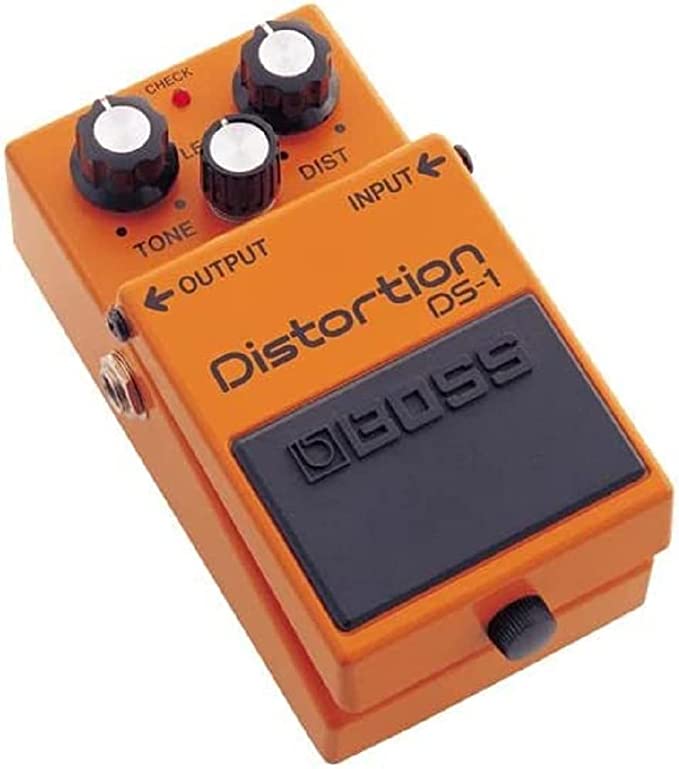
Let me tell you about the Boss DS-1 Distortion Pedal, a game-changer in the guitar effects world.
Launched in 1978, this pedal was the first from BOSS to deliver hard-edged attack and smooth sustain, becoming a go-to choice for generations of players.
Behind numerous rock legends’ signature sounds, the classic DS-1 tone remains popular among guitarists today.
This pedal’s innovative distortion circuit, developed by BOSS engineers, sets this pedal apart.
This unique design includes transistor and op-amp gain stages, creating tight, hard-edged gain with rich harmonics while preserving each guitar’s distinct qualities.
To make the most out of this pedal, you’ll find three knobs for versatile sound control.
The distortion knob provides an incredible range, from a mild boost to full-throttle gain.
The revolutionary tone circuit gives you more sound control than typical tone-forming components.
Coming in a distinct orange color and sporting dimensions of 8.75 x 5.5 x 3 inches and weighing 0.49 kilograms, the well-built Boss DS-1 Distortion Pedal is ready to unleash its power on stages and studios around the globe.
- My Review
After getting my hands on the Boss DS-1 Distortion Pedal, I can confidently say this is one interesting piece of equipment.
As I plugged it into my set-up, a certain excitement washed over me, knowing the strong legacy of this bright orange pedal.
Right away, I started tinkering with its intelligently designed controls and was instantly delighted by the iconic DS-1 tone it delivered.
That unique circuit design of the DS-1 worked like magic in preserving the true essence of my guitar while blending in hard-edged attack and smooth harmonics.
Unafraid of exploring its full potential, I dialed the distortion from a mild boost to quite an aggressive growl.
Just as I hoped, the pedal reacted as advertised and adapted gracefully to the immense diversity of my playing dynamics.
As I discovered its powerful and novel tone-shaping capabilities, I fell deeper into this pedal’s endless possibilities.
The innovative tone circuit helped me sculpt intricate high and low frequencies by adjusting the ratio between their cut off.
As a result, a treasure of desired sounds appeared before my ears, ranging from cutting rhythmic sections to those smooth, fat lead voices.
However, it should be noted that some musicians might find the pedal’s bottom end a bit limiting.
As a result, adjusting the settings to cater to my preference took some tinkering.
But truth be told, the minor con does not overshadow the countless astonishing features this influential gear offers.
- Pros:
- Classic DS-1 tone, influential sound.
- Wide distortion range.
- Powerful tone shaping.
- Cons:
- Some issues with power switch/signals.
- Doesn’t come with an adapter.
- Limited bottom end.
Encompassing influences from varied backgrounds and glorified by rock legends, the Boss DS-1 Distortion Pedal is a fascinating combination of authenticity, inspiring tone, and an impressive range of sound-shaping agility.
Experimenting with its unique capabilities left me visibly enthused, undoubtedly earning its rightful place on my pedalboard.
Here are the ratings I’ll give to the Boss DS-1 Distortion Pedal:
My final verdict is that the Boss DS-1 Distortion Pedal is iconic and influential, with a classic tone and powerful tone-shaping capabilities.
Despite some downsides, such as signal and power switch issues, and limited bottom end, it remains a worthwhile investment for guitarists seeking a versatile and well-loved pedal from a renowned brand.
TC Electronic SKYSURFER Reverb Pedal
Studio-grade reverbs with award-winning TC Electronic algorithms.
SKYSURFER REVERB offers studio-quality reverb with award-winning TC Electronic algorithms, providing lush, transparent tone without compromising your original sound. It features a sturdy metal chassis, 3-position switch, and easy-to-use controls for a classic reverb tone with modern features.
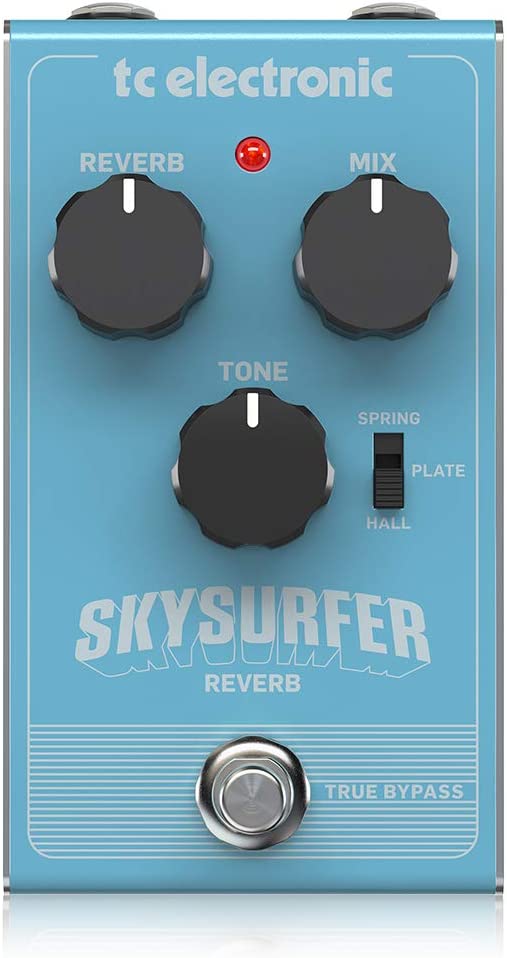
The TC Electronic Skysurfer Reverb pedal brings studio-quality reverb to your guitar setup with its clever design and top-notch engineering.
This pedal includes three distinct, versatile reverb types – Spring, Plate, and Hall – each providing a unique sound signature to shape your tone precisely.
Crafted with a durable metal chassis, this reverb pedal can endure tough gigs and hold up on any pedalboard.
The Skysurfer Reverb features true bypass for maximum signal fidelity, ensuring your guitar’s raw tone shines through when the pedal disengages.
One key quality of this pedal is its ease of use – hallmarked by an intuitive control layout consisting of Reverb, Mix, and Tone knobs and a 3-position switch to select your desired reverb type.
If you appreciate the award-winning TC Electronic reverb algorithms, then the compact Skysurfer Reverb pedal is worth exploring.
Likewise, guitarists who need a simple yet reliable and high-quality reverb can appreciate this practical and budget-friendly option.
- My Review
Having experienced the TC Electronic Skysurfer Reverb pedal, I can attest that it packs quite a punch for an affordable, compact pedal.
Its studio-quality algorithms, efficient design, and solid metal chassis make it a worthy addition to a guitar setup.
With three distinct flavors of reverb – Spring, Plate, and Hall – this pedal offers an array of soundscapes to enhance my guitar tone.
Playing with the Skysurfer Reverb, I found the Spring setting especially enjoyable, providing that lush, surf-inspired sound that harkens back to old-school spring tanks.
Fiddling with the Plate and Hall settings delivered equally gratifying ambient effects, suitable for various musical styles and contexts.
The true bypass feature piqued my interest, too – meaning my guitar’s natural tone wasn’t sacrificed while enjoying the pedal’s lush ambiance.
Navigating the interface proved seamless, with its Reverb, Mix, and Tone knobs easily allowing for adjustments to taste.
Autumn of versatility lay within these knobs and the 3-position switch, which toggles between the reverb choices.
The pedal excels in providing a user-friendly experience, perfect for guitarists, experienced or new to the world of guitar effects.
There is a deer forest of good arguments in favor of the Skysurfer Reverb pedal, but it has drawbacks.
The noise generation – a hissing sound in some settings – in certain situations was noticeable, detracting from an otherwise quality performance.
Here are the ratings I’ll give to the TC Electronic SKYSURFER Reverb Pedal:
Additionally, some reverb simulations might feel unnatural to players accustomed to premium gear.
Putting minor glitches aside, the TC Electronic Skysurfer Reverb is undeniably a robust, budget-friendly pedal that guarantees ambient flair and convenience for the discerning musician.
- Pros:
- Quality studio-grade reverb algorithms.
- Sturdy built-like-a-tank metal chassis.
- Three versatile reverbs: Spring, Plate, Hall.
- Cons:
- Potentially noisy pedal, may produce hiss.
- Some users find sound unnatural.
- Issues with intermittent functionality.
My final verdict is that the TC Electronic SKYSURFER REVERB is affordable for those looking for a basic, well-built reverb pedal.
Its versatility, good brand reputation, and value make it an attractive choice for budget-conscious guitar players.
However, its potential noise issues and occasional unnatural sound might concern some customers.
It’s worth considering, particularly for those not concerned with nailing specific reverb tones.
Mooer Black Secret Distortion Micro Pedal
Classic distortion tones in a pocket-sized pedal.
Moore Black Secret is a distortion micro pedal that provides a wide range of tones, from mild overdrive to heavy distortion. It features a 3-band EQ circuit and True Bypass switching for a clean signal path and a compact pedalboard-friendly design.
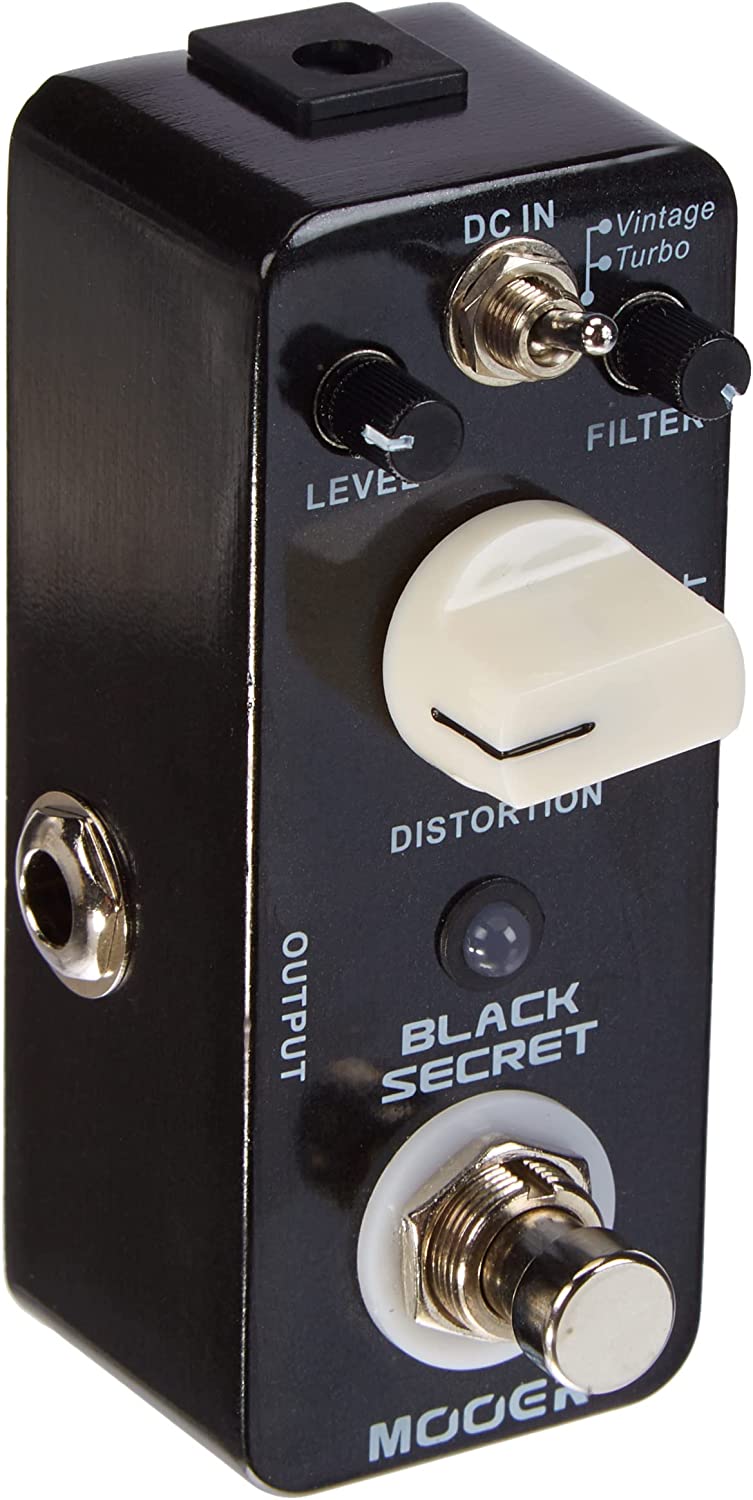
This space-saving Mooer Black Secret distortion micro pedal is designed with a compact yet full-metal shell that fits perfectly on crowded pedalboards.
One of its prominent features is dual working modes: vintage and turbo.
The vintage mode captures classic rock’s essence, providing a warm, smooth, and vintage distortion sound.
On the other hand, the turbo mode generates a powerful, gritty tone with over double the output of the vintage mode, perfect for heavier, modern rock styles.
Crafted by Mooer, a renowned brand in the guitar pedal industry, the Black Secret has dimensions of 1.75 x 4.25 x 2.25 inches and weighs in at just 0.16 kilograms.
In addition to the unique distortion modes, fine-tuning the pedal’s tone provides endless possibilities for guitar players experimenting with various distortion tones.
- My Review
Upon thoroughly testing the Mooer Black Secret distortion micro pedal, I’ve found it incredibly versatile and useful to my setup.
This compact pedal brings a robust, full-metal casing that easily fits on crowded pedalboards, saving space without sacrificing performance.
Regarding the dual working modes, the vintage mode delivers a warm and smooth distortion sound reminiscent of those classic rock tones that we all strive to recreate.
In addition, the mid-bottom end provides the depth needed for powerful guitar soundscapes, and the midrange response impressively holds its own even compared to more high-end distortion pedals.
Switching over to the turbo mode, the pedal steps things up a notch and cranks out more than twice the maximum output of vintage mode.
This leads to an aggressive, gritty distortion sound perfect for modern rock styles or musicians wanting to nail that heavier edge.
Rediscovering the growls and snarls of rock has never been more satisfying, thanks to this pedal.
Despite the Mooer Black Secret offering an excellent range of tonal options, there are a few criticisms.
First, the pedal is not a true bypass, which may be a point of contention for tone purists.
Additionally, it seems that a few units have had microphonic issues – make sure to test the pedal upon receiving it.
Regarding user-friendly values, the small knobs on the pedal could make precise adjustments slightly more challenging compared to larger pedals.
However, this is an obvious trade-off for the compact form factor.
Here are the ratings I’ll give to the Mooer Black Secret Distortion Micro Pedal:
All in all, the strengths and weaknesses considered, this distortion pedal is an excellent budget-conscious option for guitar players.
Covering various sonic territories while maintaining authentic tones, the Mooer Black Secret truly captivates a range of players; it’s difficult for anyone to argue against that at this price point.
- Pros:
- Great Rat/TRat replica at low price.
- Small size, perfect for pedalboards.
- Vintage and Turbo mode options.
- Cons:
- Some units have microphonic issues.
- Not true bypass.
- Limited headroom on Vintage setting.
My final verdict is that the Mooer Black Secret is a great-value Rat/TRat replica with versatile features and an impressive tone, making it a solid addition to any pedalboard despite some minor performance and brand concerns.
Why should you consider cheap pedals?
You should consider cheap pedals for several reasons, whether you are a beginner, an experienced musician, or just someone looking to experiment with different effects.
We will explore the benefits of budget-friendly pedals, including their functionality, sound quality, ease of use, versatility, and compatibility with various instruments.
– Affordability:
One of the most obvious advantages of cheap pedals is their price.
High-quality, professional-grade equipment can quickly become expensive, and not everyone has the budget to invest in expensive gear.
Cheap pedals allow those with limited resources to access various effects without breaking the bank.
For beginners, investing in budget-friendly gear is a practical way to explore different soundscapes and learn which effects best suit their playing style without spending a fortune.
– Value for money:
Another reason to consider cheap pedals is the value for money they provide.
Many budget-friendly pedals offer impressive sound quality and functionality, rivaling the performance of more expensive counterparts.
In addition, the competitive market has pushed manufacturers to continuously improve their products, even in the low-cost segment, allowing musicians to access high-quality gear at affordable prices.
– Experimentation and creativity:
Cheap pedals are an excellent option for musicians looking to expand their sonic horizons or experiment with new effects.
Many budget pedals provide unique and interesting sounds that enhance a guitarist’s creativity and inspire new compositions or playing styles.
By investing in cheap pedals, musicians can build a diverse and versatile pedalboard without putting a significant dent in their wallets.
– Portability and ease of use:
Cheap pedals often feature compact designs and streamlined interfaces that make them easy to use and transport.
These pedals are typically smaller and lighter than their high-end counterparts, making them perfect for musicians on the go or those with limited space for their gear setup.
The simplicity of budget pedals also reduces the learning curve for newcomers – with fewer features and controls to navigate, new users can master their effects in a shorter period.
– Versatility:
Many cheap pedals can be used with instruments like bass guitars, keyboards, or even vocals, further increasing their value.
Musicians who play multiple instruments can benefit from a collection of budget pedals that can be used interchangeably among their different instruments without significantly compromising sound quality or performance.
– Building a backup rig:
Professional guitarists often require multiple setups for various situations, such as rehearsals, live performances, or studio recordings.
Cheap pedals are ideal for creating backup rigs or secondary pedalboards, providing musicians with a cost-effective solution for maintaining consistent sound across different instruments and environments.
– Famous guitarists using cheap pedals:
Renowned musicians like Kurt Cobain, Jack White, and Josh Homme have used cheap pedals to create their signature sounds.
This highlights that musicians can achieve extraordinary results with budget gear, reinforcing that talent and creativity can outweigh the need for expensive equipment.
– Opportunity for upgrading and customization:
For those who enjoy tinkering with their gear, cheap pedals can act as a starting point or a canvas for further modification and experimentation.
Many musicians choose to upgrade components or customize the circuitry of their budget pedals to produce unique sounds or performance enhancements.
Despite these benefits, it is essential to remember that the quality of cheap pedals can vary significantly between brands and models.
Thorough research, reading reviews, and testing gear when possible will help ensure that you invest in a product that meets your expectations and provides the best value.
How do you know if a cheap pedal is of good quality?
Determining the quality of a cheap pedal can be challenging, as budget-friendly options may vary significantly in terms of sound, build quality, and overall performance.
However, you can confidently select a good-quality cheap pedal to integrate into your setup by conducting thorough research and considering key factors.
Here are some steps to help you evaluate and identify high-quality budget guitar pedals:
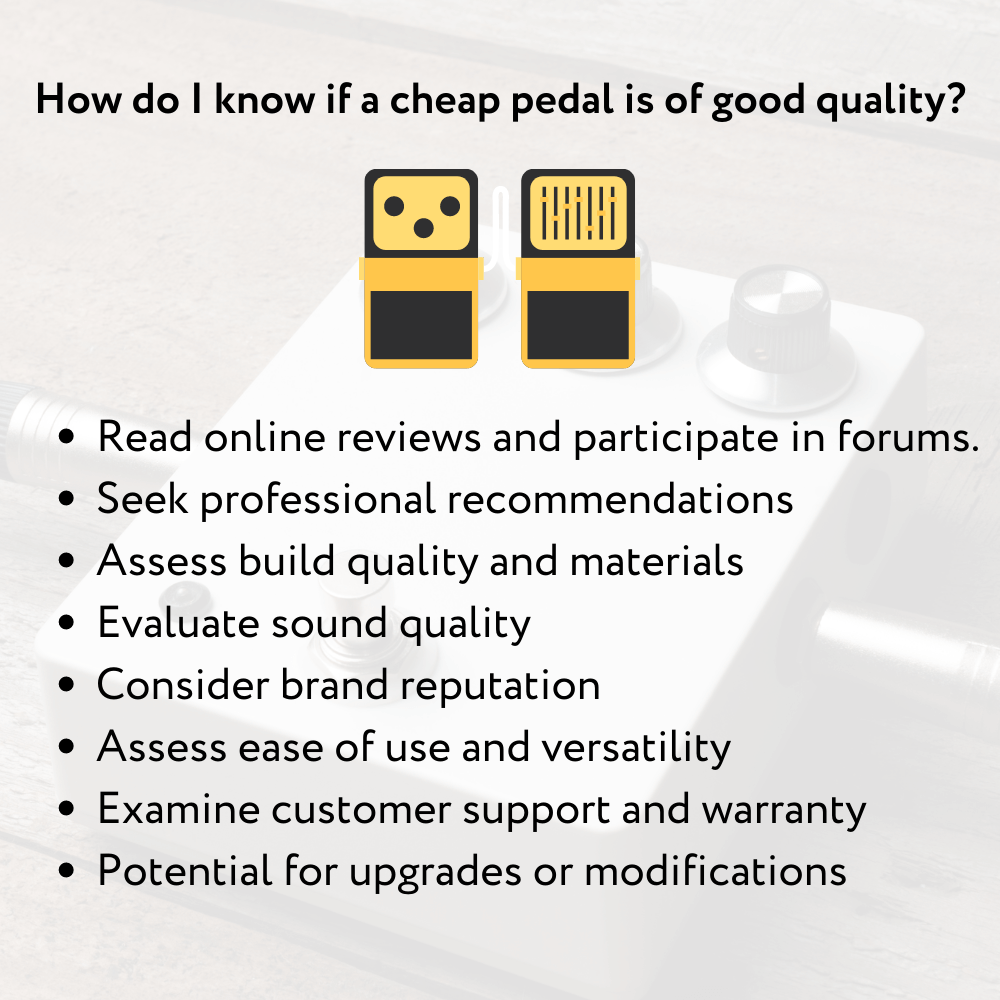
– Read online reviews and participate in forums:
One of the best ways to gauge the quality of a cheap pedal is by reading online reviews and joining guitar forums and communities.
Fellow musicians often share their experiences with various pedals, providing valuable insights into their performance, reliability, and sound quality.
Websites such as Amazon, YouTube, and various guitar-related blogs can be excellent sources of information to help you decide.
– Seek professional recommendations:
Reach out to musicians you trust, such as friends, instructors, or favorite artists on social media, and ask for their recommendations for good-quality budget pedals.
These individuals may have first-hand experience with certain pedals and can provide helpful insights to guide decision-making.
– Assess build quality and materials:
A good-quality cheap pedal should have a robust construction and be made from durable materials to withstand regular use.
Inspect the pedal’s casing and components, including jacks, switches, knobs, and internal circuitry, to determine its durability.
High-quality budget pedals usually feature metal or tough plastic casings, sturdy switches, and connectors designed for repetitive use without malfunctioning or signal loss.
– Evaluate sound quality:
While sound preferences are subjective, a high-quality budget pedal should deliver a pleasant tone that suits your playing style.
Research different pedals within your budget, focusing on the specific effects that interest you, such as distortion, overdrive, modulation, or ambient effects.
Listen to audio samples or video demonstrations to assess the pedal’s sound quality.
If possible, test the pedal in person or compare recordings of the pedal to higher-priced models to ensure that the cheap pedal’s performance is satisfactory.
– Consider brand reputation:
Brands with a solid reputation for delivering good-quality, budget-friendly pedals are likelier to produce products with consistent standards.
Please familiarize yourself with such brands within your budget and take note of musicians who endorse or use their products.
Companies with a strong track record are often more reliable regarding product quality.
– Assess ease of use and versatility:
Good quality cheap pedals should be user-friendly and versatile, enabling musicians to adjust settings easily and explore various tones.
Look for pedals with intuitive controls and user interfaces that simplify operation and facilitate experimentation.
Additionally, consider whether the pedal is compatible with other instruments and various playing styles to ensure it offers value beyond its low price point.
– Examine customer support and warranty:
A reputable manufacturer should stand by their products by offering customer support and warranties that protect against manufacturing defects.
When considering a cheap pedal, research the brand’s reputation for customer service and available warranty information to ensure that you have recourse should any issues arise.
– Potential for upgrades or modifications:
Some musicians may want to modify or upgrade their cheap pedals to improve performance or achieve unique sounds.
Investigate the pedal’s internal circuitry and design to determine if it can be modified or has room for improvements.
A good-quality base product that can be customized according to your preferences is a worthwhile investment.
Are there any downsides to using cheap pedals?
While cheap pedals can offer several benefits, such as affordability and the opportunity for experimentation, there can be downsides to using budget-friendly options.
Therefore, weighing the pros and cons before integrating cheap pedals into your gear setup is essential.
Here are some potential downsides to consider when using cheap pedals:
– Lower build quality and durability:
One of the main drawbacks of cheap pedals is their construction, as budget options may not have the same build quality and durability level as higher-end models.
Cheaper materials and less robust components could compromise a pedal’s lifespan and performance, leading to malfunctions, signal loss, and wear and tear more quickly than pricier alternatives.
– Limited sound quality or versatility:
Cheap pedals may not deliver the same sound quality or versatility level as more expensive ones.
While some budget-friendly options can rival high-end models in tone, it may be more challenging to find cheap pedals that provide the exact sound you are looking for or fully replicate their pricier counterparts’ performance.
– Signal noise and interference:
Some cheap pedals can introduce unwanted noise, such as hum or hiss, into your signal chain, degrading your overall sound quality.
This can be particularly problematic in recording situations or when using multiple effects pedals simultaneously.
Higher-end pedals are often better equipped to minimize signal noise and maintain clear, noise-free tones.
– Smaller feature set:
Budget pedals may have fewer features, controls, and options than higher-end models.
This potential lack of versatility can limit the range of sounds or creative possibilities you can achieve with the pedal.
The reduced feature set may not be a significant drawback for some musicians.
Still, for those who require more flexibility and control over their sound, a more expensive pedal with a wider range of functions may be worth the investment.
– Compatibility with other gear:
Cheap pedals may not always be compatible with certain instruments, amplifiers, or other effects pedals.
While some budget options work well in various setups, others may struggle to deliver consistent performance across different equipment combinations.
Moreover, compatibility issues can affect sound quality and functionality, leading to tone degradation or malfunctions in certain scenarios.
– Inconsistency between units:
Some budget pedals may suffer from inconsistent production, meaning the quality and performance can vary significantly between individual units.
This means that the same pedal model purchased by two people could have different sound qualities or characteristics, making online recommendations inconclusive or inconsistent regarding actual performance.
– Resale value:
Cheap pedals often have a lower resale value than their higher-end counterparts.
This may not be a crucial factor for every musician. However, investing in high-quality pedals with a stronger resale value could be more financially advantageous for those who frequently buy, sell, or trade their gear in the long run.
– Aesthetic considerations
While the appearance of a pedal may not be a critical factor for some musicians, budget pedals can sometimes lack the same aesthetic appeal as higher-end models.
High-quality pedals often feature more thoughtful designs, custom paint jobs, or attention to detail.
In contrast, cheap pedals may look less visually appealing, making them less enticing for those who value the appearance of their gear.
How to order pedals on a pedalboard?
There is no one-size-fits-all approach to ordering pedals on a pedalboard, as the optimal arrangement largely depends on the specific sound you’re aiming for.
Usually, though, you will see guitar players mostly agreeing with this order:
Tuner > Filters/Dynamics > Pitch-based Effects > Overdrive/Distortion > Modulation > Time-based Effects > Looper
Aside from that, some general guidelines can help you achieve a balanced and versatile setup.
Let’s talk in detail about the order we just mentioned, but feel free to experiment and adjust to your own preferences:
- Tuner: Place your tuner pedal first to ensure your signal is in tune before passing through the other pedals.
- Filters and dynamics: Wah-wah, envelope filters, compressors, EQs, and noise gates should come next. These pedals affect your sound’s dynamic and tonal aspects, so it’s best to place them early in the chain.
- Pitch-based effects: Octavers, harmonizers, and pitch shifters should come after filters and dynamics since these pedals alter the pitch of your signal and work best with a clean, unprocessed sound.
- Overdrive and distortion: Overdrive, distortion, and fuzz pedals typically come next. They shape your guitar’s core sound, and placing them before most other effects ensures that those effects receive a strong, consistent signal.
- Modulation effects: Chorus, flanger, phaser, and tremolo pedals should be placed after overdrive and distortion effects. We do this to allow these pedals to add depth and movement to your sound without becoming overly distorted or overbearing.
- Time-based effects: Delay and reverb pedals should be placed towards the end of your signal chain. This allows them to create a sense of space and depth around the other effects, simulating the sound of a room or hall.
- Looper: If you use a looper pedal, it should be placed last in the chain. This ensures that you’re looping the entire signal, including all the effects you’ve applied.
Remember, these are just general guidelines and what generally works and sounds good.
The most important thing is to experiment and find the arrangement that best suits your personal sound and style.
For example, here’s one pedalboard signal chain that I always use:
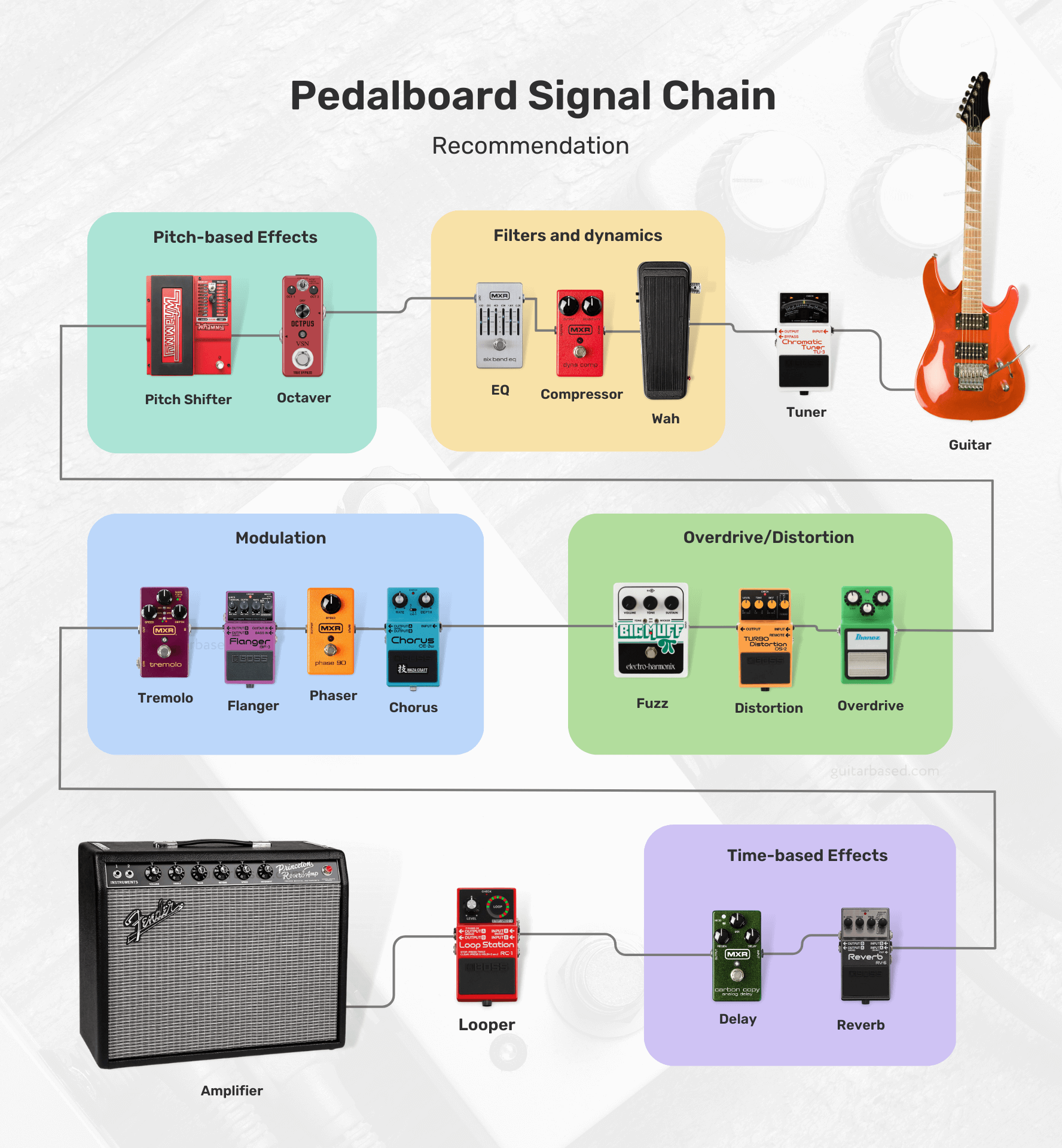
Feel free to swap the order of pedals, try different combinations, and test out unconventional setups until you find the one that works best for you.
For those interested, I’ll leave you with most of the possibilities that you’ll encounter and how to order them.
- Tuner
- Filters/Dynamics:
- Volume
- Wah
- Auto-Wah
- Compressor
- Noise Gate
- EQ (Equalizer)
- Pitch-based Effects:
- Octaver
- Harmonizer
- Pitch Shifter
- Overdrive/Distortion/Fuzz:
- Boost
- Overdrive
- Distortion
- Fuzz
- Modulation:
- Chorus
- Phaser
- Flanger
- Univibe
- Vibrato
- Tremolo
- Time-based Effects:
- Delay
- Echo
- Reverb
- Synth/Bitcrusher:
- Synth
- Bitcrusher
- Acoustic Simulator
- Multi-Effects
- Utility:
- Buffer
- A/B/Y Switcher
- MIDI Controllers
- Looper
Boutique vs. Mass-Produced pedals
Boutique pedals are generally built with higher-quality components and craftsmanship, resulting in better durability and longevity.
These pedals often feature unique and innovative designs, providing a wider range of tones and effects that may not be available in mass-produced options.
Here are a few examples of boutique pedals:

All the manufacturers also tend to have a more personal approach, with better customer service and the ability to customize pedals according to the user’s preferences.
However, boutique pedals are usually more expensive due to the smaller scale of production and the use of premium components.
Mass-produced pedals, on the other hand, are more affordable due to their larger scale of production and the use of cost-effective components.
These pedals are widely available and offer a range of popular effects, making them accessible to a larger audience.
Here are a few examples of mass-produced pedals:

The quality control for mass-produced pedals can vary depending on the brand and model, but many are reliable and offer good value for the money.
As for one of the downsides, you’ll find that mass-produced pedals may not have the same level of uniqueness or innovation as boutique options.
On the other hand, they may not provide the same level of customer service or customization options.
The choice between boutique and mass-produced pedals depends on your personal preferences, budget, and desired sound.
If you’re looking for unique tones, higher-quality components, and a more personal experience, boutique pedals may be the way to go.
But I would say, for those who are on a budget and need access to popular effects, mass-produced pedals might be a better fit.
It’s worth trying out both types to see which best suits your needs and playing style.
How much should you spend on a guitar pedal?
If I were in your position, I would first determine my budget and specific needs before deciding how much to spend on a guitar pedal.
For beginners, it might be more reasonable to start with affordable, mass-produced pedals to explore different effects without spending too much.
Guitar pedals can range in price from around $30 to over $400, depending on the brand, quality, and complexity of the effect.
As your skills and understanding of your preferred tone develop, you can gradually upgrade to higher-quality or boutique pedals.
One thing I would do is consider which effects are essential to your playing style and prioritize purchasing those first.
Allocating a larger portion of your budget to the most important pedals might be a wise choice, especially if you only need a few basic effects.
However, if you require a wide array of effects, you may want to consider more budget-friendly options or multi-effects units.
Keep in mind that higher-priced pedals often come with better build quality, unique features, and improved sound quality.
But I would also say that price is not always directly correlated with quality or suitability for your needs.
Sometimes, a more affordable pedal can deliver the exact sound you’re looking for, while a higher-priced option might not meet your expectations and are only expensive because of the brand reputation.
Can you use a guitar pedal with a bass guitar?
You can certainly use a guitar pedal with a bass guitar.
But it’s crucial to be aware that some guitar pedals may not be specifically designed to accommodate the frequency range of a bass guitar.
This could result in a less-than-ideal performance or an altered tone that might not be what you were expecting.
If you’re feeling adventurous and eager to experiment with your sound, don’t hesitate to connect your guitar pedals to your bass guitar.
This can be a fun way to explore different sonic possibilities, and you might even stumble upon some unique tones that complement your playing style perfectly.
Using a guitar pedal with a bass guitar may not always produce the desired results.
In some cases, the low-end frequencies might be lost, or the effect could sound too harsh or muddy.
To avoid these issues, you could consider looking into pedals that are specifically designed for bass guitars.
These pedals are engineered with the bass frequency range in mind, ensuring that your low-end remains intact and the effect sounds as intended.
In addition to bass-specific pedals, there are also multi-effects processors and pedals that cater to both guitar and bass players, offering a wide range of effects and tonal options.
These versatile units can be a great solution if you play both instruments and want a single device to cover your needs.
How to properly power your pedals?
When it comes to powering your pedals, you want to make sure you’re doing it right to avoid any noise issues or potential damage.
First, check each pedal’s power requirements, which you can usually find in the manual or on the pedal itself.
You’ll want to pay attention to the voltage (usually 9V, 12V, or 18V) and current (measured in milliamps or mA).
Now, you’ve got a few options for powering your pedals.
You can use individual power supplies or batteries for each pedal, but that can get messy and inconvenient.
I’d recommend going for a pedal power supply or an isolated power brick.

For example here are a few ones I recommend:
- Voodoo Lab Pedal Power 2 Plus Isolated Power Supply (My favorite)
- Rowin PW-1 Guitar Pedal Power Supply (Cheapest)
These babies can power multiple pedals at once, and the isolated outputs help prevent noise and ground loop issues.
Just make sure the power supply you choose can handle the voltage and current requirements of all your pedals.
When you’re connecting everything, use good quality power cables and keep them neat and tidy to avoid a tangled mess.
You might even want to use cable ties or cable organizers to keep everything in order.
In love with guitars, and gear; expert in all things music! Been writing about guitars for about 5 years and counting. Born in the ’90s. Alma Mater: University of Havana. Always curious, trying to understand the world. #TeamFender

